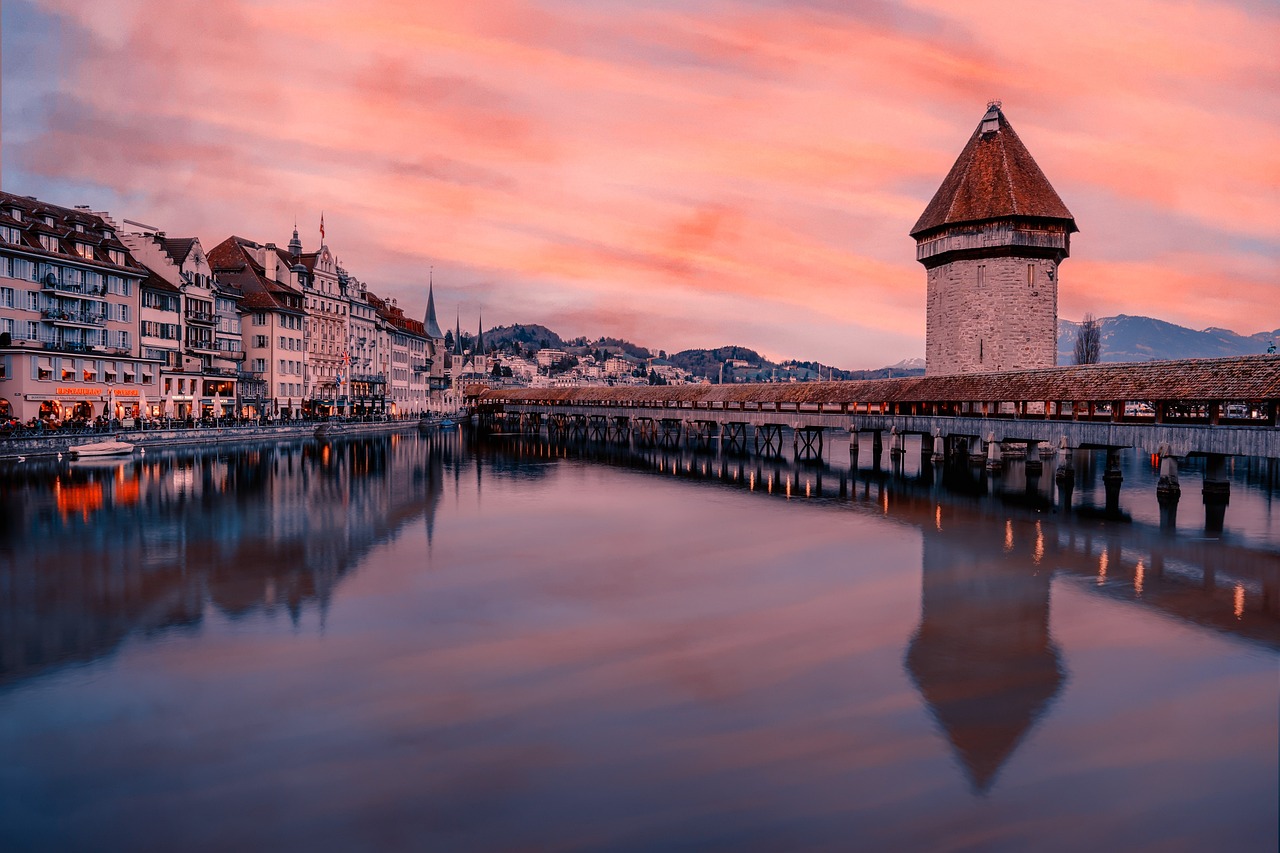

Self Guided Walking Tour of Lucerne (With Maps!)
This website uses affiliate links which earn a small commission at no additional cost to you.
Famed for its meticulously preserved medieval architecture overshadowed by the grandeur of snow-capped Alps, Lucerne stands out as one of Switzerland’s most charming cities. Nestled snugly on the banks of its namesake lake, its vibrant Altstadt (Old Town) is flanked to the north by a 14th-century defensive wall known as Museggmauer (Musegg Wall).
The town’s origins trace back to St. Leodegar Abbey, founded in the year 840 AD, in the region then referred to as Luciaria. The source of this name remains uncertain, potentially linked to the Latin term for pike fish, “lucius,” suggesting a pike fishing location along the Reuss River. However, a more popular explanation associates it with the Latin word “lucerna,” meaning “lantern.”
In 1178, the town gained independence and emerged as a significant hub for trade. It joined the ranks of growing Swiss confederacy towns, attracting newcomers with its allure. In 1798, nine years following the commencement of the French Revolution, the French military entered Switzerland, leading to the downfall of the old confederacy and the establishment of a democratic government.
During the latter half of the 19th century, Lucerne transformed into a sought-after haven for artists, nobility, and prominent figures. In 1866, German composer Richard Wagner settled here, while British Queen Victoria elevated the city’s prominence with her 1868 visit. Renowned American writer Mark Twain further popularized Lucerne through his travel accounts after two visits, in 1878 and 1897.
Lucerne’s reputation as a stylish getaway contributed to its role as one of the pioneering epicenters of modern-style tourism. Several of the city’s most iconic structures originate from this era, including the 1896-built Lucerne Railway Station.
Positioned where the Reuss River exits the lake, Lucerne boasts numerous bridges. The most famous among them is the Chapel Bridge (Kapellbrücke), Europe’s oldest covered bridge, constructed in 1333. Downriver, another notable bridge stands—the Spreuer Bridge (Spreuerbrücke), completed in 1408.
The dual spire towers of the Church of St. Leodegar, named after the city’s patron saint, perch atop a small hill just above the lakefront. Initially constructed in 735, the current Renaissance-style edifice was raised in 1639.
Another unmissable local gem is the sculpture of a dying lion (the Lion Monument, or Löwendenkmal), situated within a small park adjacent to Löwenplatz.
How to get to Lucerne
By Train: This is the far easiest way to travel through Switzerland. The Luzern (Lucerne) Railway Station is strategically situated in the heart of the city, gracing the shores of the picturesque Lake Lucerne. Train tickets for high-speed and local trains can be purchased from the blue, grey and red ticket machines which are throughout the station.
By Car: Navigating the centre of Lucerne by car can be quite challenging due to its narrow streets, many of which are one-way, pedestrian zones, and the limited availability of parking spaces, which are often expensive and difficult to find. Daytime Camper Parking is reasonably priced and not too far from the city centre.
Blue zone parking : This is limited during the day to one hour and you must use a blue time disc, set to the nearest forthcoming half hour mark. At night it is unlimited till the morning.
White zone Parking: Unless stated otherwise, white zone is paid parking where parking sign states maximum parking time (usually 90 min).
Yellow Zones Parking: These are private or reserved for companies and may only be used by them or their clients and guests.
Guided or Self Guided Tour of Lucerne
While the guide below is all you need for an in-depth exploration of Lucerne, if you want to have a local guide take you I recommend the Private Walking Tour with a Local Guide .
Bahnhofplatz
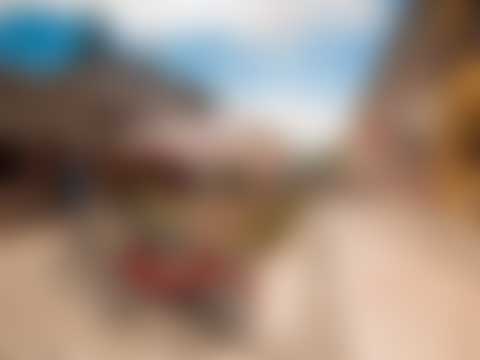
Bahnhofplatz is located just outside the train station.
Bahnhofplatz serves as the central transportation hub in Luzern and the entire Central Switzerland region. Positioned in front of the station, this area acts as a launch point for buses connecting various parts of the town. Along the lakeside, an opportunity to embark on a leisurely cruise around Lake Luzern presents itself through boat services. Beneath the square lies the expansive RailCity shopping mall, interconnected with pedestrian walkways that lead to different sections of the town.
The grand stone arch marks the entrance to the historic former train station, originally constructed in the late 19th century, a time when Switzerland and Luzern attracted considerable tourism due to their steam-powered train networks. Tragically, a fire razed the station in 1971, and it was subsequently replaced with a contemporary facility. Presently, the arch discreetly conceals ventilation openings for the sizable underground parking facility underneath. This location has become a popular gathering point for local adolescents and individuals experiencing homelessness during evenings. A visit to the complimentary public restrooms here serves as a stark reminder that while free access to toilets is a blessing for some, it remains a privilege for others.
Kapellbrücke (Chapel Bridge)

Head through the arch of ‘Torbogen Luzern’ away from the train station. Turn left before you get wet in the lake and cross over the Seebrücke (See bridge as See is the German word for lake). You can see the Kapellbrücke (Chapel Bridge) in front of you.
To your left on the corner is a post office Crafted by Gustav Gull, a renowned Swiss architect of the late 1800s and early 1900s, this structure was conceived under his guidance. Gustav Gull’s architectural prowess also extended to the Swiss National Museum, positioned just across from Zurich Main Train Station. Constructed in the Neo-Renaissance style, this edifice was conceived during the late 1800s, shortly after the establishment of Switzerland as a contemporary nation. Adorning the upper reaches of the building, you’ll find four allegorical statues that symbolize Post, Telegraph, Shipping, and Railways – representing the duties of the fledgling Confederation.
The Chapel Bridge, an enclosed wooden pedestrian bridge, stretches diagonally across the Reuss River within the confines of Lucerne. Named in honour of the nearby St. Peter’s Chapel, this bridge holds a distinctive attribute: it houses an array of interior paintings that trace back to the 17th century. Although many of these artworks were lost in a fire that consumed much of the centuries-old structure in 1993, extensive restoration efforts ensued. As a result, the Chapel Bridge stands as Europe’s oldest wooden covered bridge and the world’s oldest enduring truss bridge. It bears the dual roles of Lucerne’s emblem and Switzerland’s most renowned tourist draw.
In its inception during 1333, the bridge was a component of Lucerne’s defensive system. It connected the older town on the right bank of the Reuss River to the newer town on the left, providing a shield against potential threats from the south of Lake Lucerne. Originally exceeding 200 meters (660 ft) in length, the bridge has undergone shortening over the years due to various alterations and riverbank adjustments, now measuring 170 meters (560 ft) in length.
Lucerne boasts a peculiarity in that all three of its wooden pedestrian bridges—the 14th-century Hof Bridge (now extinct), the Chapel Bridge, and the 16th-century Spreuer Bridge—incorporated painted interior triangular frames. This artistic element is not present in any other wooden footbridges across Europe. Crafted by the local Catholic painter Hans Heinrich Wagmann during the 17th century, the Chapel Bridge’s paintings depict significant events from Lucerne’s history. Out of the original 147 paintings that adorned the bridge before the 1993 fire, 30 have been meticulously restored.
Tip: Savour its enchanting allure during the nighttime hours, when the city illuminates, swans glide through the waters, flowers add to the ambiance, and a romantic aura pervades. Both riverbanks offer splendid shopping opportunities and an array of exceptional restaurant
Kapellplatz

At the end of the church, we are heading the a square behind the church. Either walk up the stairs to the back of the church or turn to your right to have a look at the tower, then follow around the building around.
This great square is called Kappellplatz or Chapel Square. Its name comes from St. Peter’s chapel, the oldest church in Lucerne. The building date is uncertain, but we do know that eight centuries ago when the town was organizing the priest of St. Peter’s was appointed as the caretaker of the people. He was Lucerne’s first mayor. Today the chapel offers masses in several languages. The Chapel also gave its name to Kapellbrücke (Chapel Bridge) you just came across.
hapel Square, the inaugural site for Lucerne’s Carnival festivities. While you might have heard of Switzerland’s Carnival reputation being dominated by Basel, I don’t intend to dispute that. My assertion is that Lucerne’s Carnival is a spectacle worth witnessing, and the Luzerners take justifiable pride in it.
Nestled at the heart of the square is the Carnival Fountain, a relatively recent addition from the early 20th century. However, the origins of the carnival legend trace back much further, dating to the 15th century. Can you spot the gentleman sporting a crimson hat on the fountain? His name is Brother Fritschi, and it is said that his final resting place is beneath this very fountain. While a medieval graveyard exists nearby, the certainty of Brother Fritschi’s grave remains elusive. Yet, historical records confirm that this burial ground was designated for unmarried women, laborers tending to farms, orphaned children, and strangers. It’s possible that it encompasses a farmer from the mid-1400s. Legend recounts that whenever this farmer visited the town, he brought mirth and libations. Upon his passing, he left funds to one of the guilds, with the stipulation that wine be served to the less fortunate during the Carnival. To this day, the guilds continue to honour his wish.
The Fritschi parade, tracing its origins to the 15th century, marks the commencement of the Carnival Season. The procession features a life-sized straw effigy of Fritschi, escorted by various guilds and clubs, with drummers and pipers leading the way and soldiers with substantial beards and armour following suit. This parade not only heralds the onset of the Lenten Season but also commemorates a historical military triumph.

We will head north up Hans-Holbein-Gasse to Sternenplatz or Star Square. this picturesque square with amazingly beautiful murals on the buildings around. The square’s star-like shape, first described in the 17th Century, is thought to have given the Sternplatz its name. Follow the road around to the left and walk down Schlossergasse. At the small square with the well turn left, then first right into Kapellgasse. You soon come to Kornmarkt.
The origins of the Kornmarkt trace back to 1356, and true to its name, it functioned as the central grain market of the city until the 19th century. Notably, the ground floor of the Town Hall began serving as a storage space for grain starting from 1438, while the upper sections of the building transitioned into a functioning Town Hall in 1447.
In all of Lucern’s Old Town squares – Kornmarkt, Hirschenplatz, and Weinmarkt – you will find intricate painted facades vividly portray a range of themes, spanning from the art of beer-brewing to the realm of medicine.
Hirschenplatz

Leave diagonally opposite the Town Hall clock tower, turn first right to reach Hirschenplatz.
Search for the edifice distinguished by the sign of the stag. This plaza derives its name from the former Hirschen Hotel, the term “Hirschen” translating to “stag.” Interestingly, despite this name association, historical records reveal that the square originally served as a marketplace for pigs. Furthermore, the section in the southwestern corner earned the moniker “sweet corner.”
The Little Goose-Man Fountain, also known as Gänsemännchenbrunnen was made in 1891. Goldsmith Carl BossardBrunner had a reproduction of the original Little Goose-Man sculpture from the German Museum in Nuremberg, crafted by Pankraz Labenwolf in 1530. This replica, created by Heinrich Viktor Segesser, was then erected in Hirschenplatz. The tale of the Gooseman follows a similar narrative, culminating in the same outcome: his wife sends him to town to sell geese, and upon returning, his hands and pockets are empty, yet his spirits are filled with cheer.
The square also has Dornach House, a Neo-Gothic structure in predominantly white, hosts a mannerist fresco. This artwork vividly captures the 1499 Battle of Dornach, the final conflict between Switzerland and the Holy Roman Empire, celebrating the Swiss victory over Emperor Maximilian I’s forces. Despite significant odds – 6,000 Swiss against 16,000 Roman Empire soldiers – they achieved victory, showcasing their unwavering determination.

Walk to the square to the right of the Dornach House.
Despite its name, this square originally served as a fish market before gaining fame for its association with wine. It’s worth recalling that Lucerne’s roots extend back to being a fishing village before rising to prominence along the Gotthard Trade Route. The square’s strategic location, coupled with its alleyways seamlessly connecting to the river, made it an ideal spot for a fish market. Moreover, both the butchers’ and fishermen’s guildhalls found their place here, as evident from the guild signs that can be spotted in the surroundings.
Progressing into the early 1900s, Lucerne witnessed an increase in shopping and tourism. Consequently, the decision was made to renovate the old town, leading to the square’s renaming as “Weinmarkt” or “Wine Market.” This period of revitalization also witnessed the restoration of numerous murals and the addition of new ones. Notably, the verdant building at the far end of the square features a painting from 1928 depicting the wedding at Cana, where Christ performed the renowned wine miracle. This painting serves as a reminder of both wine commerce and the religious festivals that once graced the square. For nearly two centuries, the Passion of Christ was dramatically re-enacted here during the Easter Season, spanning two days with each performance lasting 12 hours.
The central fountain in the Platz pays homage to St. Morris, a soldier who holds the distinction of being one of Lucerne’s patron saints. Interestingly, another Swiss town, Saint Moritz, shares his name. The original fountain is now housed within the history museum. The fountains in this region draw their water from Mount Pilatus, with ultraviolet treatment employed to eliminate germs. Regular cleaning and maintenance ensure their impeccable condition. Many of these fountains are over three centuries old and once served as the primary water source for numerous citizens at the time of their construction. Past the fountain stands the historic courthouse and town hall, a structure transformed into the Des Balances Hotel since 1836, consistently maintaining its esteemed reputation. The façade that faces the river mirrors the allure of a Venetian Palace. Conversely, the side adorned with frescoes, which now meets your gaze, was executed in the distinctive style of Hans Holbein. Holbein, celebrated as a luminary of the Northern Renaissance, is perhaps most famed for his portrait of Henry VIII.
Adorning the edifice, you’ll spot the words “Hotel Waage” positioned above the entrance. This hotel bore the earlier appellation “Waage,” which translates to “scales,” a tribute to the erstwhile courthouse that once graced this location. In the same way that murals were an emblem of prestige, a multicolored tile roof held similar significance. This very building made a pronounced statement through both its roof and façade.
Outside, on the left, stands a Linden tree, a symbol traditionally associated with justice. The penalty bench was situated in front of this Linden Tree, and it was under its boughs that justice was meted out until the early 1800s.
Rathaus (Town Hall)

Leave the square at the south west corner and folloe the road the the left. Turn right to get to the river and walk back the way you came with the river on your right. You soon come to the front of the Rathaus.
The Lucerne Town Hall, commonly referred to as Rathaus, stands as a masterpiece of Italian Renaissance architectural style, captivating many as one of the most exquisite historical edifices in Lucerne. The commencement of Rathaus’s construction dates back to 1602, and the project reached completion in 1606. This remarkable creation was crafted under the design prowess of architect Anton Isenmann.
Positioned at the heart of the Old Town, Rathaus graces the banks of the River Reuss, offering splendid photo opportunities to visitors who seek a splendid vantage point for capturing the charm of the Chapel Bridge. This experience is particularly enchanting on Tuesdays and Saturdays between 6 AM and 1 PM, when market stalls come alive, inviting tourists to browse and shop while basking in the architectural splendor.
Within the Rathaus, visitors will uncover an exhibition hall and a concert venue. As they navigate towards the dovecote, they’ll have the chance to marvel at paintings and coffered ceilings that hail from times long past. Nestled in the Rathaus attic, the dovecote offers a unique opportunity for visitors to observe and feed the resident birds, accompanied by an exhibition that delves into the history of the Rathaus doves.
Jesuit Church (Jesuitenkirche)

Head across the bridge and turn right to reach the Jesuit Church.
The Lucerne Jesuit Church stands as a Catholic place of worship in Lucerne. Notably, it holds the distinction of being the initial grand Baroque church erected in Switzerland north of the Alps.
Founded by Ignatius of Loyola in 1534, the Jesuit order actively engaged in the Counter-Reformation, a Catholic response to the emergence of Protestantism. The divide brought about by Protestant reformers like Zwingli in Zurich and Calvin in Geneva fragmented Switzerland, which was predominantly Catholic. In reaction to this, the Jesuits were summoned to Lucerne by the city’s council in 1573, with the purpose of establishing an educational institution.
Ludwig Pfyffer, Lucerne’s mayor, extended annual financial backing to the Jesuits from his personal resources. The Jesuit College of Lucerne took root in 1577 within the Ritter Palace, a structure originally erected in 1557 as a dwelling for Mayor Lux Ritter.
The construction of the associated church was initiated in 1667. By 1673, the primary exterior and façade of the church had been completed. The consecration of the church took place in 1677, even though the interior was not yet fully furnished. Various side altars remained absent, and the central altar itself was only put in place four years later, owing to financial constraints. The onion-domed towers reached completion in 1893. In the mid-18th century, the vault underwent redecoration. The inner chapel houses the original vestments of Brother Klaus, a revered Swiss patron.
Presently, while the church presents an appealing exterior along the river promenade, it’s the lavish, unaltered interior adorned in shades of pink and white that truly captivates. Entry is free, and upon stepping inside, visitors are treated to one of Switzerland’s most breath-taking churches.
Visiting Jesuit Church (Jesuitenkirche): Opening Hours: daily: 6:30am-6:30pm
Ritterscher Palace

Right next to the Jesuit Church, the Ritterscher Palace.
The Ritterscher Palace, presently housing the cantonal administration, draws in aficionados of art and history. One of its attractions is Jakob von Will’s “Dance Macabre,” an artwork of seven pictures and 23 scenes displayed in the top-floor corridor. These scenes encapsulate encounters between different social strata and death.
Once owned by Luc (Lucius) Ritter, a captain in the French King’s Regiment in Northern Italy, the palace came into being after his elevation to the leadership of Lucerne upon returning home. Eager to underscore his societal stature, he commissioned a Renaissance palazzo in the style of Florence. The renowned Italian architect Giovanni Lynzo directed the creation of the Ritterscher Palace, although he faced a grim fate, being condemned to death for heresy during its construction. Ritter himself passed away shortly thereafter. The town council oversaw the completion of the building, which was subsequently occupied by the newly arrived Jesuits starting from 1557. This remarkable structure presently serves as the seat of the cantonal parliament.
Should you be visiting during office hours, the elegant courtyard situated at the heart of the palace is open for your exploration.
Historisches Museum Luzern

Carry on up Bahnhofstrasse and turn first right to head back to the river. At the river walk along it with the river to your right.
The museum houses objects from the history of the city and canton of Lucerne , alongside items looted from various battles, such as the coat of mail of Duke Leopold von Habsburg , who fell in the Battle of Sempach. Various objects from everyday life can also be seen, as well as costumes from the Angélique Sophie Panchaud de Bottens collection, formerly in the Utenberg Costume Museum.
The building was built in 1567/1568 as a arsenal for the city and the state of Lucerne. It fulfilled this task until 1983. After three years of renovation, it was handed over to the public in 1986 as a historical museum.
Spreuerbrücke

Walk between the river and the museum to reach the Spreuerbrücke.
The Spreuer Bridge, an enclosed wooden footbridge, commences at Mills Square in the old town and extends to Pfister Alley. It’s also referred to as the Mills Bridge, and it attracts numerous tourists seeking to admire its splendid architecture and the captivating interior paintings.
The bridge’s original incarnation was constructed during the 13th century, yet it met destruction in 1566 due to a flood. Swift reconstruction followed, accompanied by the incorporation of the remarkable paintings. These paintings notably depict the Dance of Death, a prominent motif from the late Middle Ages.
Between 1616 and 1637, Kaspar Meglinger led the creation of the 67 paintings. These artworks frequently include details about the donors, such as their names and family crests. Some even boast portraits of the benefactors. Today, 45 of these paintings have persevered. The artistic treasures adorning the Spreuer Bridge have also earned it the moniker “The Dance of Death Bridge.”
Visitors are cordially invited to stroll along the pedestrian bridge at any time, but the true magnificence of the paintings is most vividly appreciated under the natural illumination of daylight.
Museggmauer (Musegg Wall)

Head up Brüggligasse which runs parallel to the river. When you pass Nölliturm, the first defensive tower turn right up the slope the the wall on your right.
The historical city wall once formed a vital part of Lucerne’s defensive structure. Presently, the Musegg Wall stands as a captivating vestige of the past, offering both intimate exploration and distant admiration.
Constructed during the 13th century, the wall and its nine towers originally comprised an inner and outer ring. Remarkably preserved, it ranks among the longest-surviving defensive walls in the nation. Those inclined to walk alongside the nine towers have the liberty to do so at any hour, as these towers are illuminated by floodlights during the night. However, only four of them are accessible to the public: Mannli, Zyt, Wacht, and Schirmer.
Mannli, signifying “little man,” stands as the second tower along the ascending ridge. It once served military purposes until the conclusion of World War II, after which it was made accessible to the general public. The Wacht Tower, also known as the Heu Tower, was originally employed for gunpowder storage. Following a lightning strike in 1701 that triggered an explosion, the tower was reconstructed. Zyt Tower, a clock tower, features the Leodegar Bell that chimes the hour preceding the city’s church clocks. As for Schirmer Tower, it once guarded the city gate.
From April to November, Musegg Wall and four of its nine towers welcome visitors between 8 AM and 7 PM, providing a remarkable opportunity to engage with Lucerne’s historical legacy.
Gletschergarten (Glacier Garden)

Pass under Schirmerturm tower and walk to the bottom of the hill. Walk along Museggstrasse until you reach Zürichstrasse then turn left. Walk along Zürichstrasse and turn left after you see The Crown of Lucerne restaurant. When you get to little lane the Gletschergarten (Glacier Garden) is to your right.
The Glacier Garden serves as a premier destination for those eager to delve into the intricacies of ice age glaciers. Visitors are guided through the museum and its gardens, where they can engage with the Rock Adventure Trail—an immersive experience allowing them to traverse through the rock formations, witnessing their formation during the Ice Age.
Housed within a traditional Swiss dwelling, the museum boasts an 18th-century mountain relief map, renowned as the world’s oldest of its kind. An interactive relief map of Switzerland also enriches the experience. Following the museum exploration, visitors can delight in the Mirror Maze. Crafted from 90 mirrors, this 19th-century labyrinth offers a delightful and captivating diversion.
An Observation Tower offers sweeping panoramas of Lucerne, allowing visitors to relish in the stunning vistas. Additionally, the park features ideal spots for relaxation or indulging in an outdoor picnic.
The Glacier Garden welcomes guests every day, from 10 am to 6 pm during the summer months, and from 10 am to 5 pm in the winter season.
Löwendenkmal (Lion Monument)

The Gletschergarten (Glacier Garden) is right next door to the Löwendenkmal (Lion Monument).
The Lion Monument, also known as the Lion of Lucerne, stands as a rock relief in Lucerne, erected in 1820 to honour the memory of the Swiss Guards who tragically lost their lives in 1792 during the French Revolution’s tumultuous events. This monument holds a place among Switzerland’s most renowned landmarks, drawing approximately 1.4 million tourists each year.
Throughout the early 17th century, a contingent of Swiss Guards had been a part of the Royal Army of France. The tragedy unfolded on August 10th, 1792, when revolutionaries stormed the Tuileries Palace. Amid the chaos, conflict erupted spontaneously after the royal family had been escorted from the palace to find refuge with the Legislative Assembly. In the ensuing struggle, the Swiss Guards, hampered by dwindling ammunition and outnumbered by the revolutionaries, were ultimately overpowered.
Approximately 760 of these valiant Swiss Guards who defended the Tuileries met their demise during the fighting or suffered massacres after surrendering. An estimated two hundred more died in captivity due to their injuries or fell victim to the September Massacres that followed.
Carved into the rock face, the monument spans an impressive ten meters in length and six meters in height. It stands as a tribute to “the loyalty and bravery of the Swiss.” The portrayal of a dying lion impaled by a spear, shielding a crest adorned with the emblem of the French monarchy, is accompanied by another shield bearing the coat of arms of Switzerland.
Mark Twain aptly described the sculpture of the wounded lion as “the most mournful and moving piece of stone in the world.”
Bourbaki Panorama

As you come out of the entrance of the Löwendenkmal (Lion Monument) park turn to your left and you can see the Bourbaki Panorama.
The Bourbaki Panorama stands as a colossal panoramic painting that serves as a tribute to the internment of around 87,000 French Bourbaki soldiers, who sought refuge in Switzerland after traversing from Prussia during the severe winter of 1871. Edouard Castres, the artist behind this creation, had first-hand experience of this event, having witnessed the horrors of war as a Red Cross worker.
This event transpired within the context of the Franco-Prussian War. General Charles Bourbaki’s French troops sought sanctuary in Switzerland, beset by starvation and disease. The Swiss military extended their assistance by providing shelter during the harsh winter months.
Spanning an immense canvas measuring 112 by 10 meters, the Bourbaki Panorama is often credited as an inspiration for the concept of 360-degree filming and virtual reality, owing to its expansive dimensions and shape. Visitors are welcome to explore this significant artwork at the museum throughout the week.
Visiting Bourbaki Panorama: Opening at 10 am year-round, the museum’s closing hours are 5 pm from November to March, and 6 pm from April to October.
Pro tip: The Bourbaki Panorama comprises two levels: the first featuring a video/slide presentation alongside several artefacts, while the upper level showcases a captivating 3D presentation with life-sized figures positioned before the actual painting. It’s advisable to acquaint oneself with the narrative to fully grasp the depicted situation.
Hofkirche St. Leodegar

Walk behind the Bourbaki Panorama along Weystrasse. When you get to the juction you shoudl be able to see the twin spires of the Hofkirche head towards them along St. Leodegarstrasse.
On your right is the Rothenburgerhaus, dating back to around 1500, is probably the most ancient wooden house in a Swiss town. While most wooden houses in Swiss towns fell prey to fires and were replaced by stone buildings, Rothenburger house was built at a privileged site near Hof Church, separated well from downtown Lucerne. Famous local chronicler Diebold Schilling lived, wrote and illustrated his chronicle here.
The Church of St. Leodegar, a Roman Catholic church from the 17th century, was finished in 1639. However, the church’s history dates back to the 8th century.
Previously, an ancient church named Monastarium Luciaria stood where the Church of St. Leodegar is now situated. Constructed around 735 or 736 AE, it enjoyed many years of patronage. Regrettably, this building was consumed by fire in 1633, leaving only two Romanesque towers intact.
The Church of St. Leodegar is often viewed as the premier example of Renaissance architecture in a church in Switzerland. It’s also renowned for its organ, crafted in 1640. When first built, this organ boasted the tallest and heaviest pipe globally. Subsequent extensions were made in 1862 and again in the 1970s, leading to its current size of 7,374 pipes and 111 registers.
Those keen on exploring the Church of St. Leodegar can do so on weekdays between 8 am to noon and 2 pm to 5 pm.
From St. Leodegarstrasse walk down the cobbled path and turn left to get to the lake. Walk with the lake on your left, cross the bridge until you are back where your started.
Tours and Activities from Lucerne
Similar blogs.
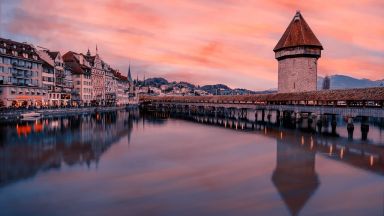
Famed for its meticulously preserved medieval architecture overshadowed by the grandeur of snow-capped Alps, Lucerne stands out as one of Switzerland’s most charming cities. Nestled snugly on the banks of its namesake lake, its vibrant Altstadt (Old Town) is flanked to the north by a 14th-century defensive wall known as Museggmauer (Musegg Wall). The town’s […]
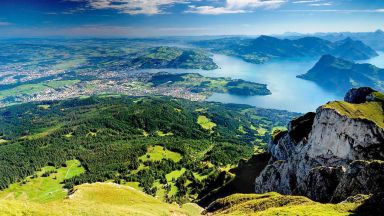
Complete Guide To Visiting Mount Pilatus In A Day
Nestled in the heart of Central Switzerland, the awe-inspiring Mount Pilatus awaits your exploration—a testament to nature’s boundless beauty. Gazing down upon Lucerne, this rugged pinnacle reaches a breath-taking elevation of 2132 meters above the tranquil sea. From the summit, a panorama of unparalleled grandeur unfolds before your eyes, showcasing not only the picturesque city […]

Lucerne: self-guided walking tour of one of Switzerland’s most visited cities
When you start browsing Pinterest for inspiration for a trip to Switzerland, you’ll find that your trip isn’t complete unless you spend at least one day in Lucerne. Set against a backdrop of majestic mountains and the crystal clear Vierwaldstättersee lake (Lake Lucerne), Lucerne is one of Switzerland’s most visited cities. So in this post, I’ll share with you my tips on the must-see sites and attractions in Lucerne, including the Kapellbrücke, Rathaus, Spreuerbrücke, Museggmauer Fortification, the Lion Monument, and more. You can use this post to plan your itinerary as you’ll also find many travel tips at the end of the post.
Lucerne is easily accessible by train . When you leave the station, you’ll be right in the city center and the most famous landmark, the Kapellbrücke, is a stone’s throw away. If you come here by car , I recommend parking at the Löwencenter shopping center (Zürichstrasse 5) on a weekday, or the parking house at the train station (Bahnhofparking P3).
Lucerne Visitor Card
When you stay at a hotel in Lucerne, you will receive a FREE Lucerne Visitor Card, which is valid for up to 14 days of your stay. This card entitles you to free use of the buses and trains in Zone 10 of the city network (which will take you, for example, to Kriens, the starting point for the cable car to Pilatus). With this card, you also get, for example, a 30% discount on the Titlis Bergbahnen and a 20% discount on guided tours of Lucerne, the Rigi Bahnen, the Stoosbahnen, or the CabriO-Stanserhorn-Bahn. All other discounts can be found here .
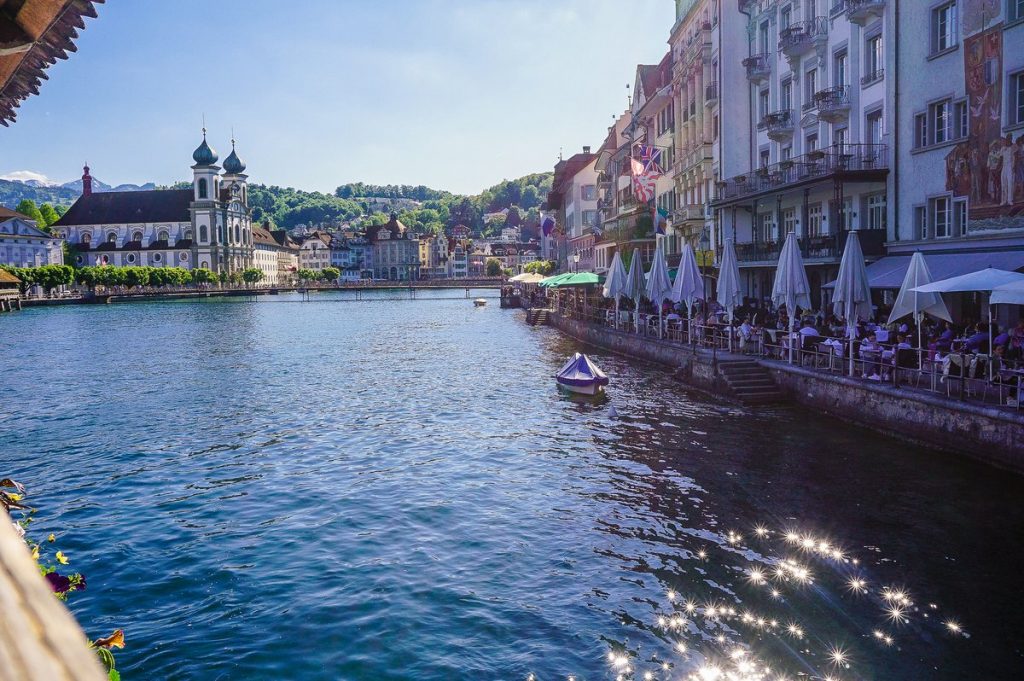
Walking tour of Lucerne Switzerland
If you only have a few hours in Lucerne, you should focus on walking around the city center and the lake area. On the map, you will find all the important points connected to form a pleasant walk that will help you discover the main attractions of Lucerne.
The Lion Monument
If you’ve parked at the Löwencenter, it’s only a few steps to the memorial, which is located in a small park just off Löwenplatz. The ten-metre lion was carved into the rock in memory of the more than 800 Swiss soldiers who gave their lives in defence of King Louis XVI during the French Revolution (during the storming of the Tuileries in 1792).
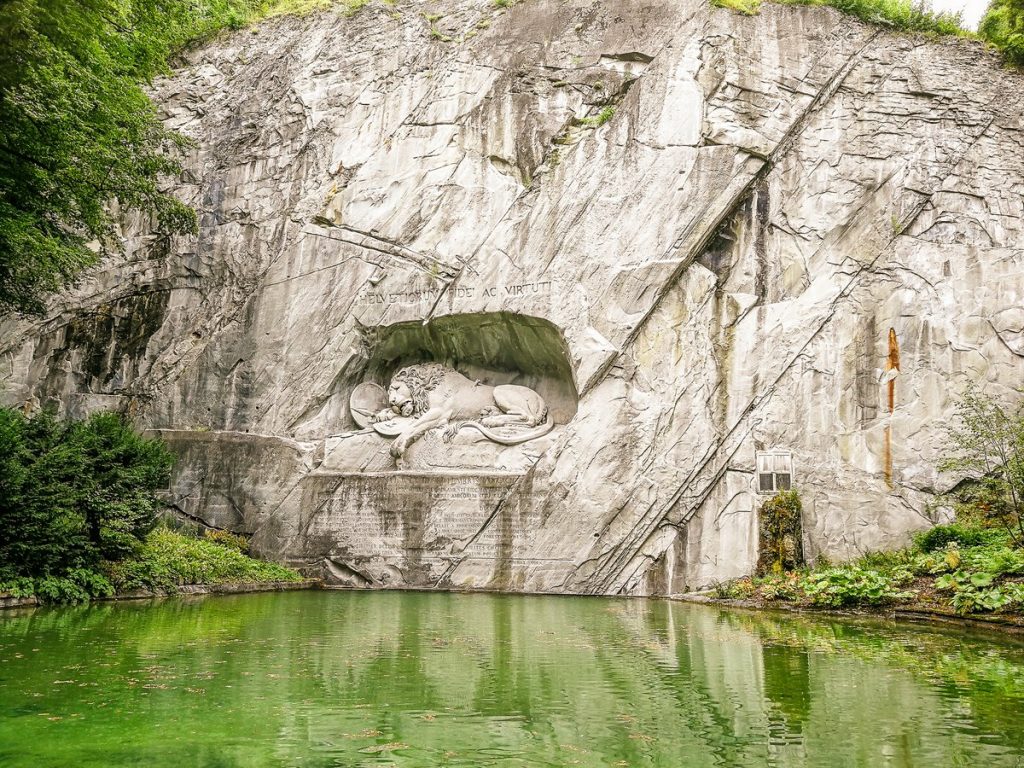
The Musegg Wall
The Museggmauer and its nine towers are part of the historic fortifications of Lucerne. 4 towers (Schirmerturm, Zytturm, Wachtturm, and Mannliturm) are open to the public. The Zytturm tower houses the oldest clock in Lucerne, dating back to 1535, which strikes the hour one minute earlier than any other clock in the city! This is one of the best viewpoints in Lucerne . On a clear day, you can see all of Lucerne, the mountains and of course Lake Lucerne from here.
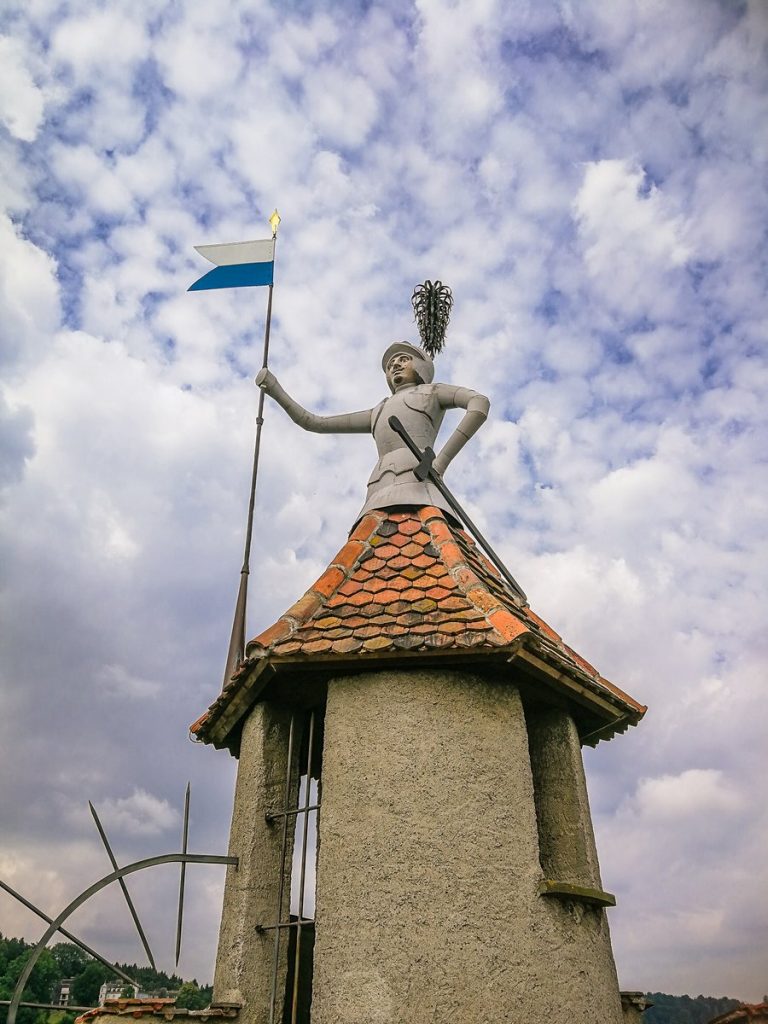
Spreuer bridge
From the last tower on the fortification, you walk along the Brüggligasse to the covered wooden bridge Spreuerbrücke. It was first built in 1408 and later rebuilt in 1568 after it was destroyed by a storm. The triangular panels feature a series of paintings by Caspar Meglinger called the Dance of Death.
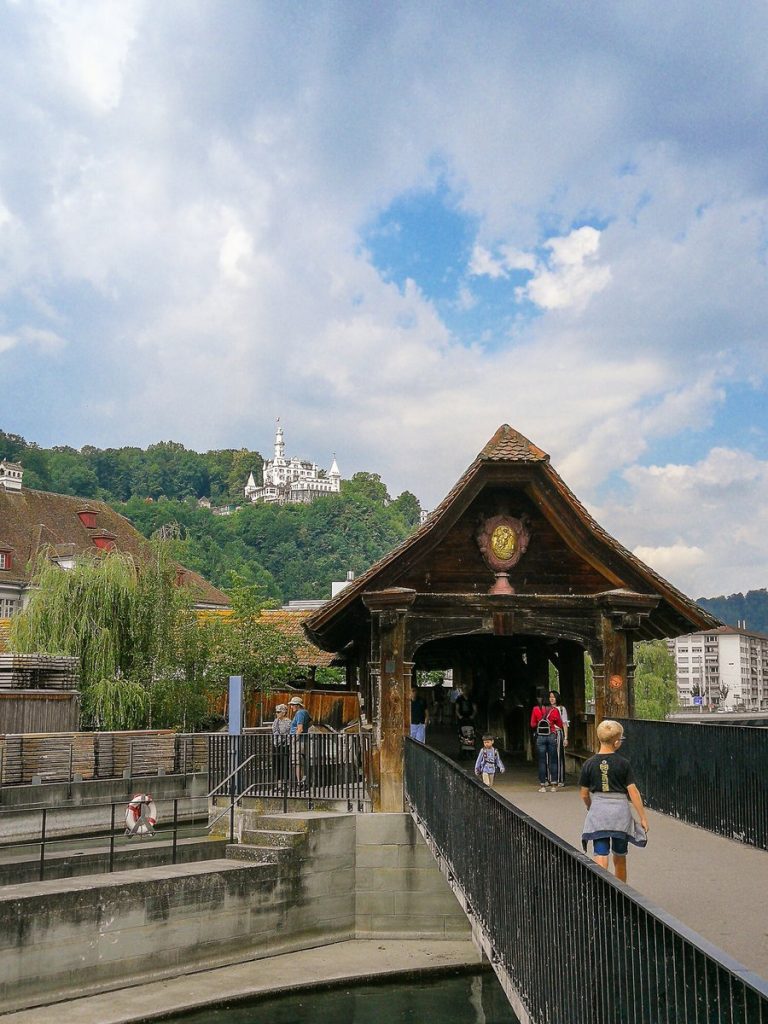
Jesuit church
The dominant landmark of the waterfront on the south bank of the Reuss river is the Jesuit church. This Catholic church, the first Baroque church built in Switzerland north of the Alps, is beautiful inside and out and worth a visit even if you are not religious.
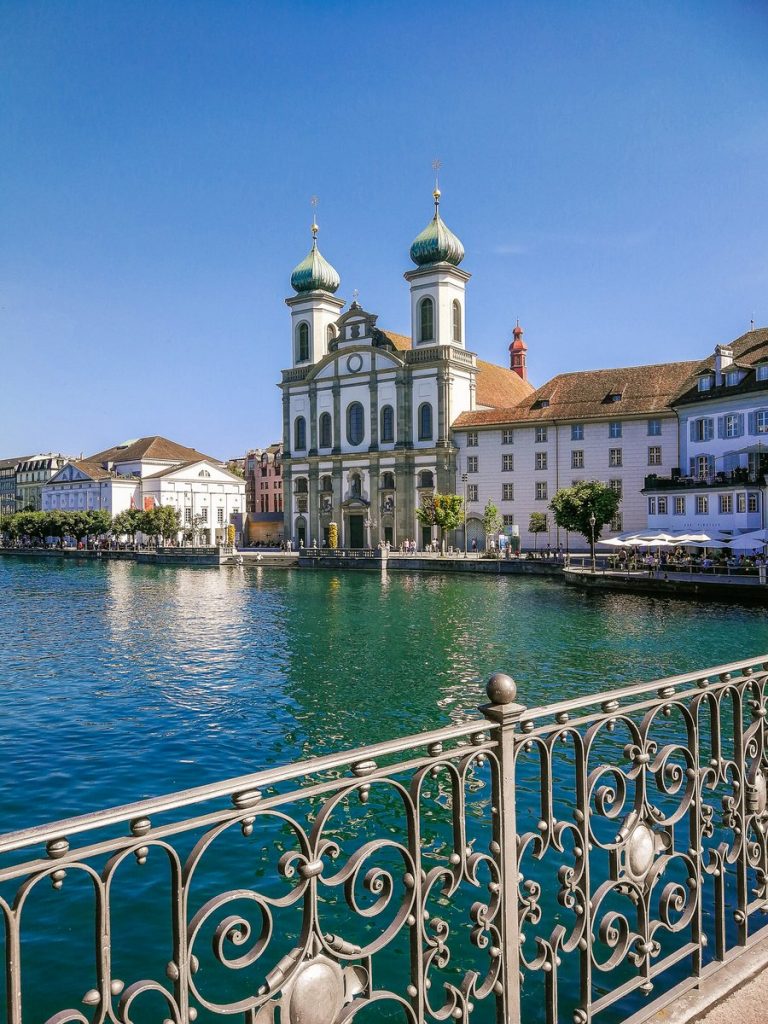
Lucerne old town
From the Jesuit church, go back a bit and cross the bridge to the north bank of the Reuss river. You’ll find yourself in the most impressive part of town. Here you’ll find Mühlenplatz, Weinmarkt, Hirschenplatz and Kornmarkt squares, all decorated with fountains and lined with colourful facades of medieval houses.
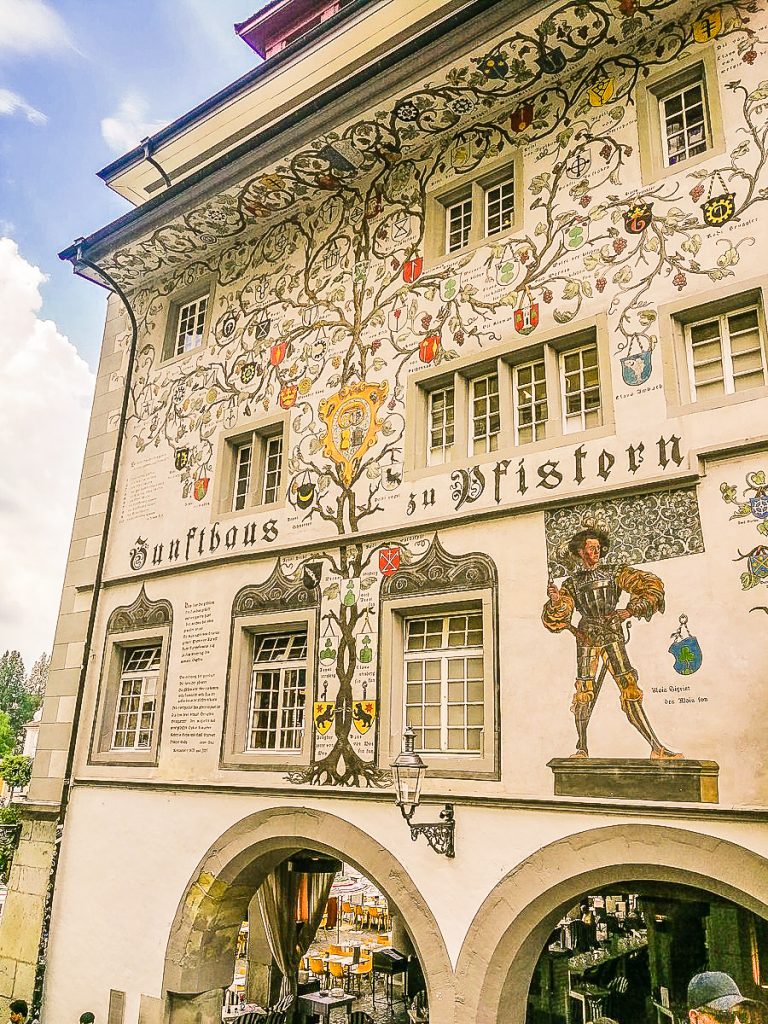
Rathausquai
Don’t forget to relax a little while walking around the city. The restaurants and cafés on the banks of the River Reuss at Rathausquai are ideal for this.
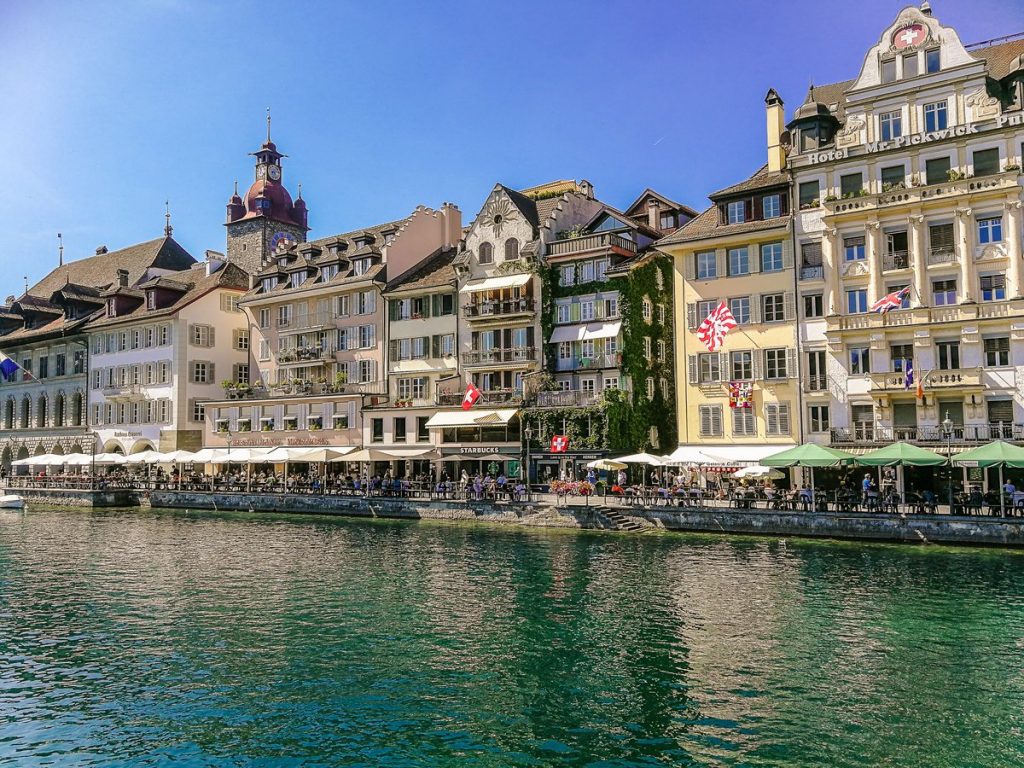
The Chapel bridge
Like the Matterhorn in Zermatt, the Chapel bridge in Lucerne is a symbol of the city. It was built in 1360 and is named after the nearby St. Peter’s Chapel. It is the oldest covered wooden bridge in Europe. It was rebuilt after a fire in August 1993. The fire also destroyed most of the 17th century triangular panels depicting scenes from the city’s history. The bridge is dominated by the octagonal Wasserturm water tower. This tower has changed its purpose many times: it has served as a prison and torture chamber to the city archives and the local treasury.
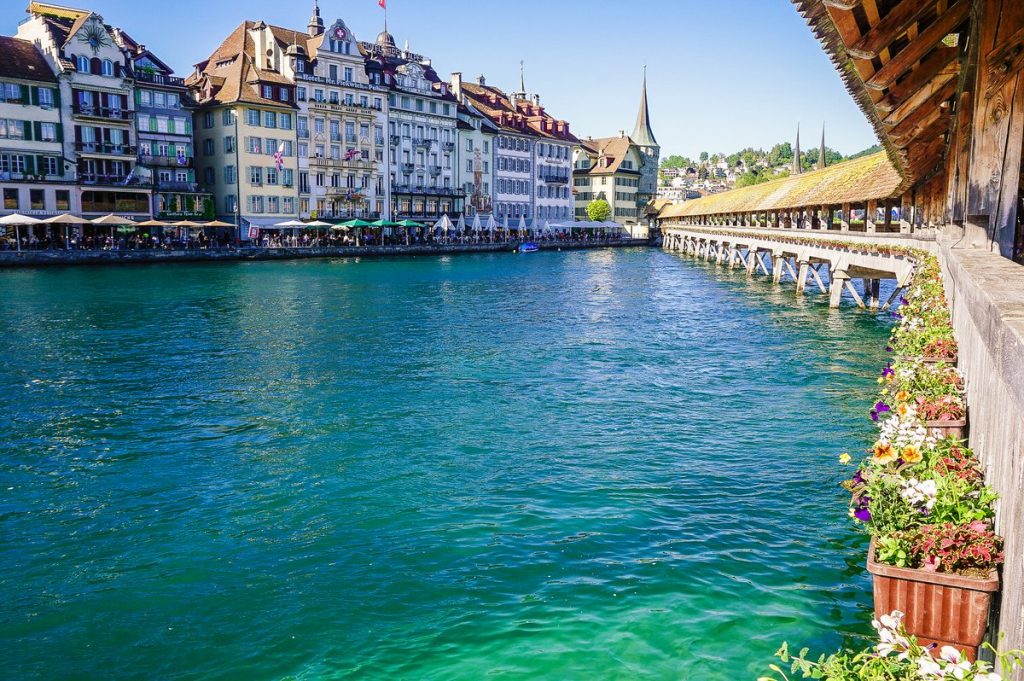
Lake Promenade
The less than half-hour walk that takes you from the city center around the lakeshore to the Lido swimming area or the Verkehrshaus transport museum is definitely worth it. The views are incredible.
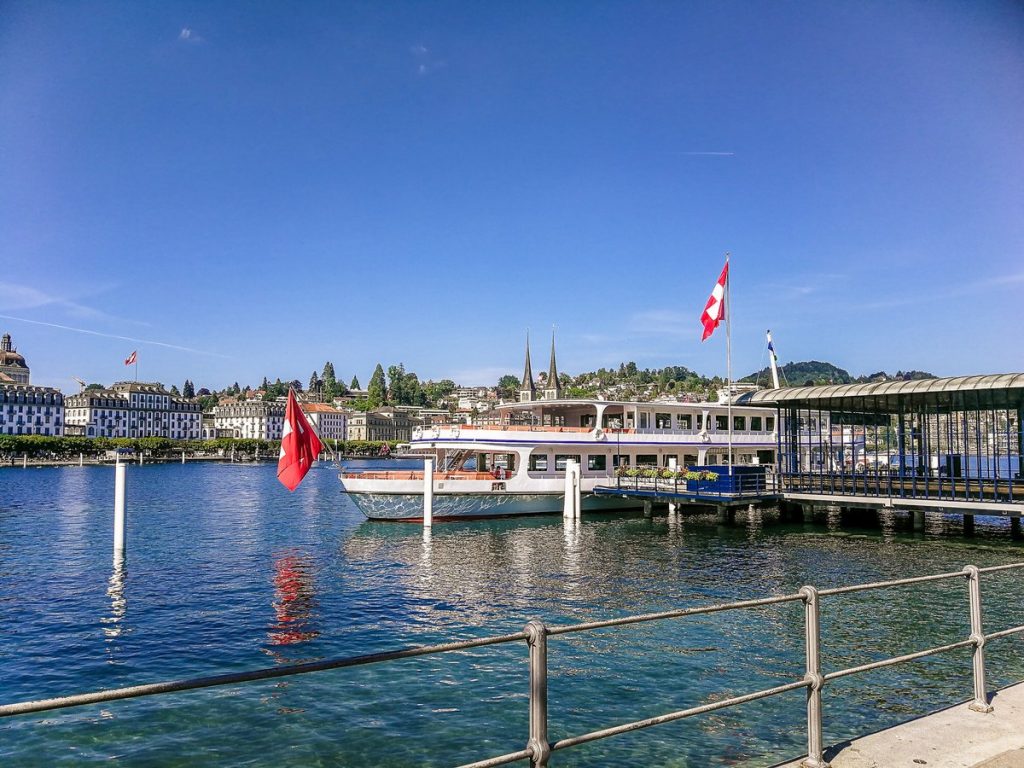
Day trips from Lucerne
The perfect weekend in Lucerne? One day to explore the city, the other in the surrounding mountains. With the Lucerne Visitor Card you get discounts on cable cars or museums, so why not take advantage of them?
Verkehrshaus Transport Museum
Switzerland’s most visited museum – what to say more! It is the place to learn about the history of road, rail, water, and air transport and space travel. There’s a lot to see (and, more importantly, experience!) here. And it doesn’t matter what age you are – young and old alike will enjoy it.
Take a ride on the Rotair – the world’s first rotating cable car. It turns 360 degrees during the five-minute journey to the top of Klein Titlis.
Mt. Pilatus
The “Dragon Mountain” can be reached either by the steepest cogwheel train in the world or by the “Dragon Ride” cable car. On the way, you can stop at the Fräkmüntegg Rope Park, which offers many attractions.
Stanserhorn
The Stanserhorn can be reached by cable car, which is unique in the world. Opened in 2012, it offers the experience of riding on the open-top terrace. From here you will have a spectacular view of the Vierwaldstättersee lake and the surrounding peaks.
Another unique experience – a trip on the steepest cable car in the world, which has a gradient of 110% (47.7º). This will take you to the mountain village of Stoos, which has about 150 permanent inhabitants. From here you can go even higher up to the top of Fronalpstock.
Bürgenstock
From Lucerne, you can get here by a special ferry, which is operated directly by Resort Bürgenstock. A technical highlight is the Hammetschwand lift – the highest external lift in Europe.
Rigi – the Queen of the mountains
Head to the iconic peak near Lucerne, which is surrounded by three lakes.
Aeschbach Chocolatier
Aeschbach Chocolatier is a family-owned company. Now in its third generation (since 1972) produces chocolate specialties according to its own original recipes. ChocoWelt – the chocolate world – can be found on the premises of its factory in the town of Root near Lucerne.
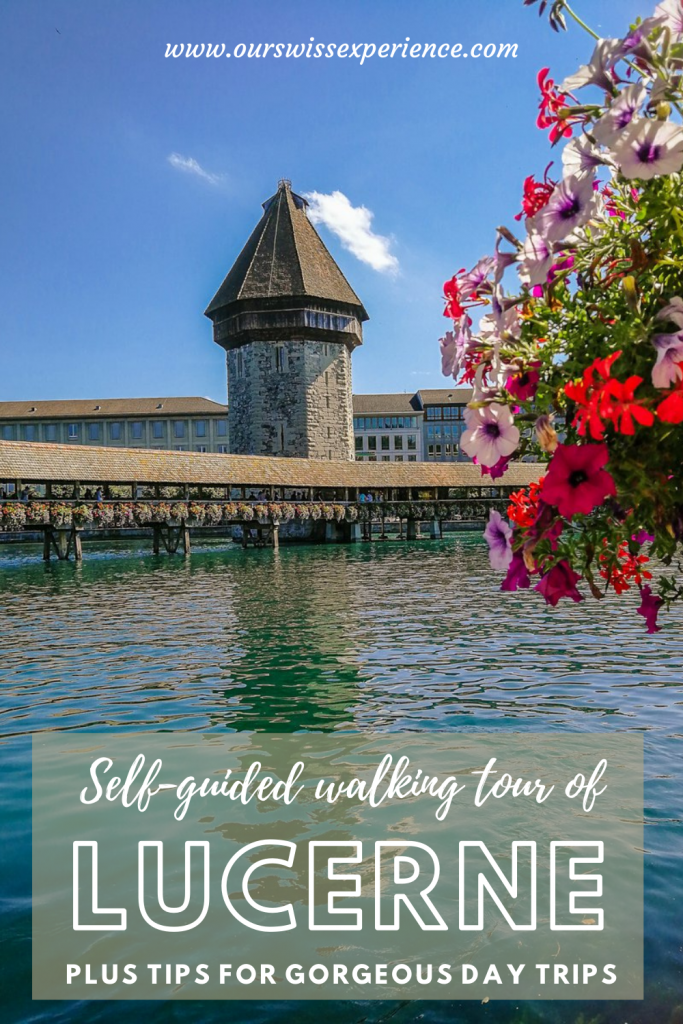
1 Comment . Leave new
[…] A self-guided walking tour of Lucerne will take you to the most beautiful and interesting sights and attractions in the city itself. But there’s more! The surrounding mountains and landscape are breathtaking and there are many great destinations within easy reach. But since there are simply too many such beautiful places to visit to list them all in one article, here are the most popular and best day trips from Lucerne. All of them are definitely worth a visit. […]
Leave a Reply Cancel reply
Your email address will not be published. Required fields are marked *
Post Comment
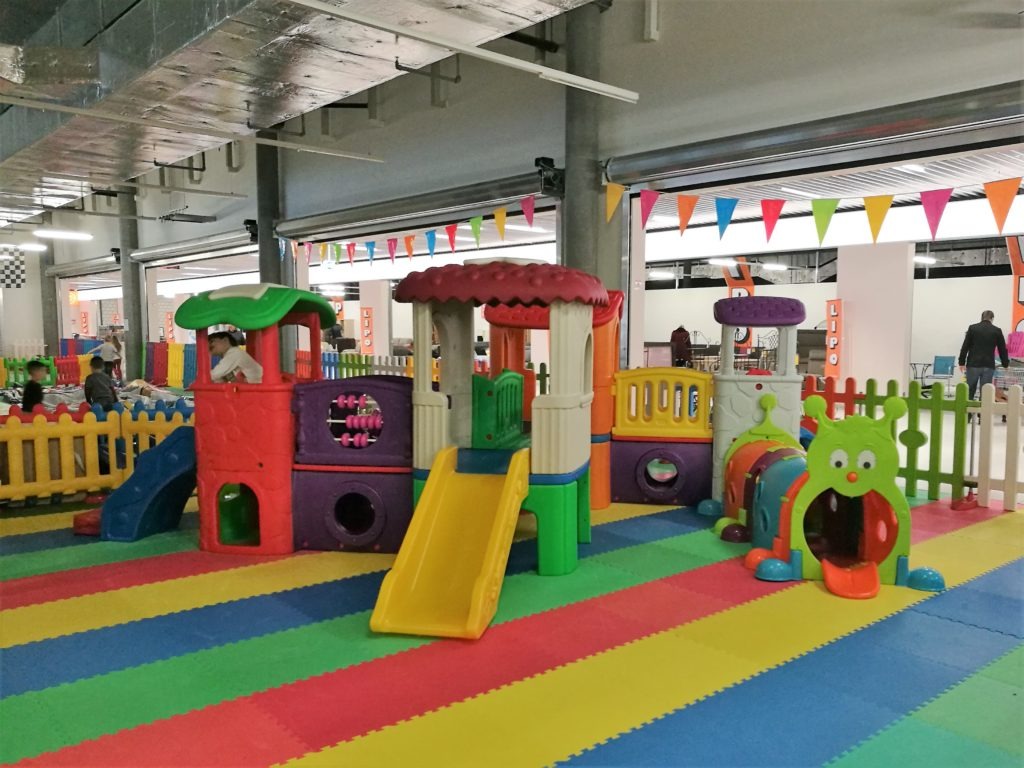
Fun for kids in Joypark Biel
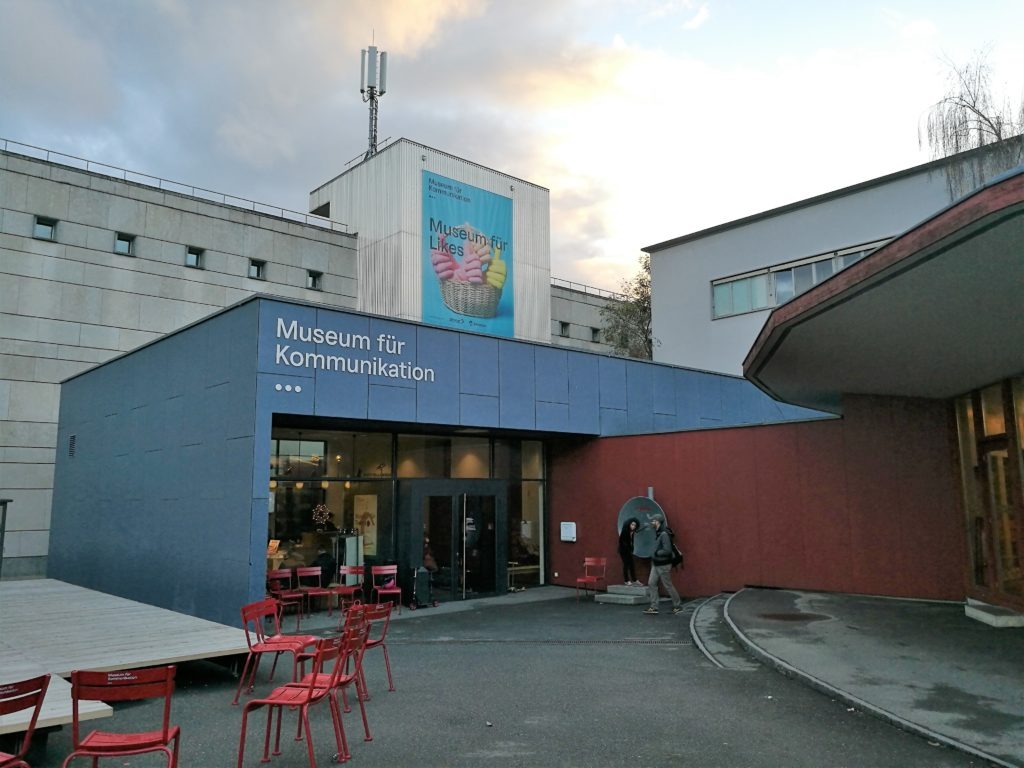
Newly opened Museum of Communication
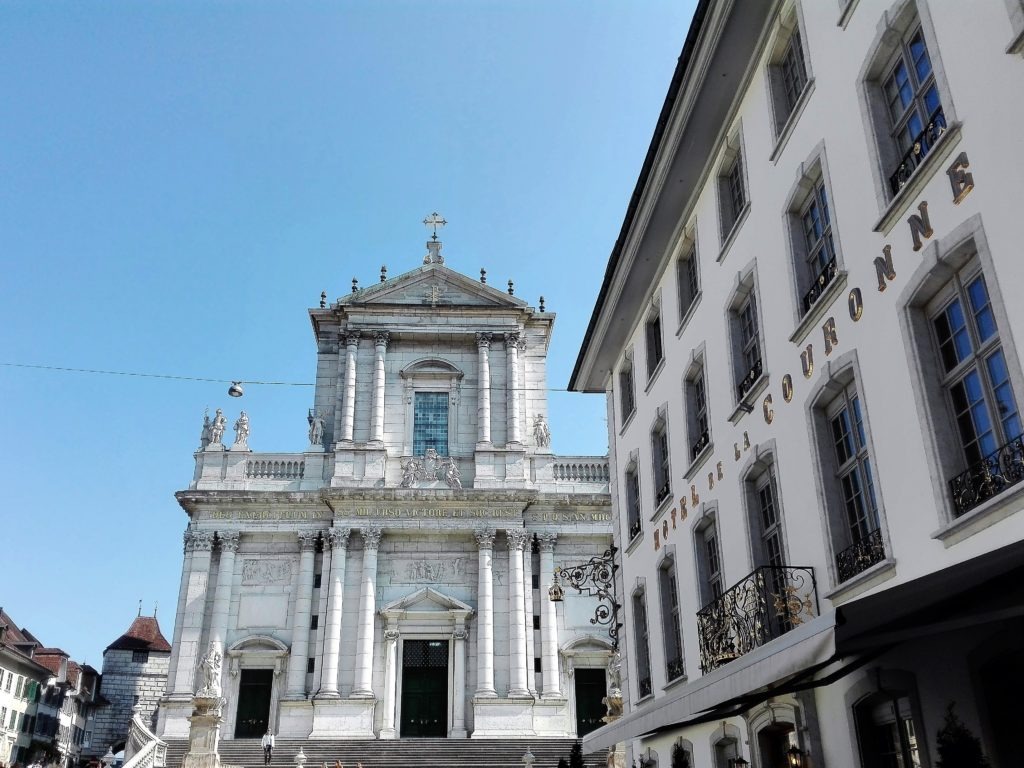
11 interesting facts, that you probably didn´t know about Solothurn

I am a member of
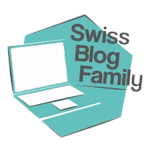
Map of activites

You may be also interested in
5 + 1 reasons for visiting Zug
Indoor playground Kiddy Dome Rohrbach
Rapperswil: a lovely one-day trip from Zurich
Hiking with kids: Marble Run Trail Hasliberg
Hiking with kids: Dwarf trail Hasliberg (Muggestutzweg)
A summer day in the holiday region Elm: 5 family-friendly acitivities
Tips for the best rope centres in Switzerland
Bogentrakt Hostel Chur: a cool stay in a former prison
5 fun things to do in Chur as a family
Foxtrail: (re)discovering the Old Town of Bern during the fun puzzle trail
Social Media
- Book reviews
- Canton Bern
- Chocolate factory
- Family activities
- Indoor activities
- Lookout tower
- Map of activities
- Show cheese dairy
- Suspension bridge
- Swiss Travel Tips
- Switzerland
- The best of canton Bern
- Theme trails
- Travel tips
- winter hiking
- with stroller
1 Day in Lucerne – A Self-Guided Walking Tour Itinerary
A one-day visit to Lucerne is perfect to explore the sites and medieval architecture of this central Switzerland city beside beautiful Lake Lucerne. The nearby snow-capped mountains are great day trips from Lucerne.
Table of Contents
One Day in Lucerne Itinerary
This itinerary makes a great 1-day visit to Lucerne.
- Enjoy a self-guided Lucerne Walking Tour of both New and Old Town.
- Cross the famous Chapel Bridge .
- Explore the towers of the Musegg Wall ; OR Visit one of Lucerne’s museums .
- Enjoy a dinner cruise on Lake Lucerne .
On a 2 nd day in Lucerne, visit anything missed on the first day OR take a day trip to the local peaks near Lucerne.
Lucerne Map – The Best Things To See in Lucerne

Lucerne Walking Tour
The best way to see the architecture of Lucerne’s colourful Altstadt (old town) is on foot. This 2-kilometre walking route travels through both Neustadt (new town) and Altstadt. It takes about an hour to walk, depending on the time spent at each spot.
Begin at the Bahnhofplatz , the huge transit hub with a parking garage beneath. The Zentralstrasse, Lucerne’s main train station, is to the south and the main dock for Lake Lucerne cruises is to the north. For help with tourist passes to Lucerne attractions or tourist information, visit the Lucerne Tourist Information centre in the train station. There is a large shopping mall beneath the station and a sizable food court for grab-and-go food.
The original train station was destroyed by fire in early 1971. Its grand main entrance was saved and stands in the middle of the Bahnhofplatz, like a gateway to the city.

To the east of the plaza is a huge building, one of the few modern-looking buildings in this part of the city.
Lucerne Culture and Convention Centre
Opened in 2000, the Kultur und Kongresszentrum Lucerne (or KKL Lucerne) has three parts: an 1840-seat concert hall, multi-function Lucerne Hall and the convention centre. There are a number of restaurants and cafes which are convenient to the dock on the lake.
The striking, glass-and-steel building’s design has won international praise for the concert hall’s amazing acoustics. Its unique ceiling, special sound-absorbing doorways and an inaudible ventilation system create complete silence enriching performance sound.

The architect designed the building to be in the middle of the lake but the city didn’t agree. To achieve the appearance of being surrounded by water, lake water flows in channels through the middle of the building.
The Lucerne Arts Museum is in the building’s convention centre.
Detour: Visit Inseli Park, just to the south of the KKL. This is a local summer hangout. Enjoy the lakeside grassy area or play ping pong at outdoor tables. Locals and tourists alike frequent two summer patio bars.
Walk back to the Bahnhofplatz and continue west along the river to the 14 th -century Kapellbrücke , one of Lucerne’s most recognized landmarks.
Chapel Bridge (Kapellbrücke)
The winding, wooden, covered bridge is over 200 metres long. It was built across the Reuss River as part of the city’s defensive system. Partway along the bridge, the 8-sided, stone Water Tower is original and older than the bridge. Over the centuries, the tower was used as the city treasury, dungeon prison and archive.

A 1993 fire began in a boat moored to the bridge. The fire spread to the bridge destroying a large portion of it. Both ends of the bridge survived as did the stone tower. The tower’s gabbled roof was destroyed.
Walk across a portion of the bridge to see the triangular roof panels. The original panels were painted in the 17 th -century, recording the development of Lucerne and Switzerland up to that point. The 1993 fire burned 81 of the 111 panels. The panels found in the centre are originals which were in storage during the fire.

The paintings were sponsored by wealthy families. To recognize their charity, the family coats of arms were added to the paintings.
The Rosengart Collection is in the gallery at the corner of Pilatusstrasse and Theaterstrasse. This is a must-do for Picasso fans. Either detour to the gallery, walking 3 blocks south along Theatrestrasse, or visit later in the day.
Follow the river west to the Jesuitenkirche.

Jesuit Church
The large, 17 th -century church was the first Baroque church in Switzerland. Its two, onion-domed towers were added in 1893. It is dedicated to Francis Xavier, co-founder of the Jesuit order. While the exterior is Baroque, the interior was redone in the mid-18 th century in Rococo style. The interior is beautiful. The ceiling murals celebrate Xavier’s life and afterlife. The church’s large organ is used by Lucerne’s music school. Enjoy the music if they happen to be practising.

Walk west on Bahnhofstrasse to the next intersection. To the left, at the end of the street is the Franziskanerkirche.
Franciscan Church
The beautiful, 13 th -century, Gothic-style church has a large pipe organ and stunning paintings. Over the centuries the interior has undergone extensive renovation but has kept its 17 th -century choir stalls and the wooden pulpit.
Return to Bahnhofstrasse and continue west. Turn right onto Pfistergasse. Walk to almost the next major cross street. Turn right and walk through an arched entrance along a covered walkway. This leads to the next covered bridge.
The Historisches Museum and the Natur-Museum Luzern are on either side of the walkway, on the south side of the river.

Spreuer Bridge
This 15 th -century, covered, pedestrian bridge is original. It is smaller Chapel Bridge and has avoided fire for more than 6 centuries. Its roof panels are a series of paintings, called Dance of Death by Kaspar Meglinger, created to remind the townspeople, who crossed the bridge daily, that death cannot be escaped regardless of social class.
The far end of the bridge was designed for wagons delivering supplies to three mills nearby. Since the middle ages, there have been mills in this area harnessing the power of the river. A fire in 1875 destroyed all but one. It was removed in 1890 making way for the city’s first hydroelectric power plant. Those turbines generated power for 90 years. They were replaced by the current power plant in 1996.

Look toward the lake. It receives its water from snow melt. A movable dam was designed in the mid-19 th century to control lake levels and protect lakeside towns from flooding. In the spring, the dam is opened by removing wooden pickets, allowing the river to flow. As the lake’s water level drops, the wooden pickets are put back in place extending the dam across the river and slowing the flow. We visited in late May and the dam was partway across the river channel. By winter, the dam is entirely in place, cutting the flow to almost nothing across the main river channel. This keeps the lake level high enough for some boats.
From the bridge, walk to the right into the pedestrian square called the Muhlenplatz . This is the start of the old town . At the top of the square, turn right and walk a block to Weinmarktgasse.
Walk a block to the pretty city square, the Weinmarkt . This was a marketplace for wine. The 15 th -century fountain has carvings of soldiers. They were to remind citizens that the town was tough and strong. Enjoy the beautiful paintings on building fronts in the square.

Continue up the street to the Hirschenplatz . This square got its name from the Hirschen Hotel which is long gone. Its sign still hangs in the square.
Turn right, walk a block then turn left onto Kornmarkt. Walk to the square outside the Rathaus Stradt beside the Town Hall clock.
Lucern Old Town Hall (Rathaus Stadt)
The first town council meeting was held in this late Renaissance-style town hall in 1606. The building continues to be used for council meetings.

Walk Furrengass to St. Peter’s Chapel . The bridge was called Kapellbrücke due to its proximity to church.
The Fritschibrunnen is in the plaza to the north of the church. Locals gather at this fountain early in the morning on the first Thursday seven weeks before Easter to start the Fasnacht festival. This is Lucerne’s annual Mardi Gras and one of their biggest parties of the year. There are parades, dancing, singing and drinking through the entire seven-day festival. Locals often take time off and visitors are encouraged to join in.

This is the end of the town walking tour. There are several options for the rest of the day.
- Return to the Bahnhofplatz. Enjoy lunch along the lakeshore or on a Lake Lucerne Cruise , or
- Explore one of the great Lucerne museums , or
- Continue walking and explore several more Lucerne attractions.
Self-Walking Tour of Lowenplatz and the City Walls
Lucerne’s oldest tourist attractions, from the early 17 th -century, are in Lowenplatz to the northeast of Old Town and the old city walls.
Begin from Bahnhofplatz or continue from St. Peter’s Chapel at the end of the Lucerne Walking Tour.
From Bahnhofplatz, walk north across the Seebrucke, the bridge over the mouth of the Reuss River. From St. Peter’s Chapel, walk east along the river to Lake Lucerne.
Walk the sidewalk north and east following the lakeshore. The main street, Löwenstrasse/Route 4, turns left. Follow it, turning immediately right onto St. Leodegarstrasse. Walk to the church with the beautiful bell towers.
Hofkirche St. Leodegar
The beautiful, 17 th -century late-Renaissance church has twin, Gothic, bell towers. The church was part of a monastery founded in 750. A 1633 fire destroyed all but the bell towers. Inside, see the beautiful, white stonework and the vaulted ceiling. The 17 th -century organ is one of Switzerland’s finest.
Walk back out to the main street, Löwenstrasse, and walk north about 4 blocks to the Lowenplatz and the Bourbaki Panorama.

Bourbaki Panorama Lucerne
The 10-metre-tall Bourbaki Panorama was painted in 1881 by Edouard Castres. It portrays, in a very lifelike, 360-degree view, the surrender of French troops to the neutral Swiss. At the end of the Franco-Prussian War in 1871, the French troops refused to surrender to the winning Germans.
The panorama was touched up in the year 2000. Many panoramic theatres were built in the 19 th century in Europe and the United States.
Walk to one of Lucerne’s more well-known tourist attractions, the Lowendenkmal, about a block north, on Denkmalstasse.
Lion Monument
The sculpture of a dying lion was carved into the stone, cliff-face in the 1820s. It is 10 metres long and 6 metres tall. It memorializes the Swiss soldiers who died defending King Louis 16th in the 1792 Paris attack during the French Revolution. This beautiful park was a sandstone quarry when the lion was carved.
Adjoining the park to the north is the Gletschergarten.
Glacier Garden of Lucerne
Sixteen potholes, called kettles, were revealed when glaciers melted in the area 20,000 years ago. In 1873, the Amrein family built the Glacier Garden around the kettles. Enjoy walking the paths through the rocks and plants.
The Amreins collected all manner of items which are displayed in the museum ’s eclectic collection. A mirror maze recreating Granada Spain’s Alhambra was created for the 1896 Geneva National Exhibition. It was moved to the garden in 1899.
Walk back down Denkmalstrasse to Lowenplatz. From the square, continue 2 blocks south to Hofstrasse. Turn right onto Museggstrasse. This street runs parallel to the watchtowers and old walls of the city constructed around 1400. Veer right onto Schirmertorweg and climb up to the Museggmauer.

Musegg Wall Lucerne
Walk the path on top of the old city ramparts, for stunning views of the city and Lake Lucerne. There are 9 stone towers, some open to the public. The wall and the towers (including the Schirmerturm, Männliturm, Wachtturm, Zytturm) date back to late 14th century.

Lucerne Museums
These are several of Lucerne’s interesting museums.
Sammlung Rosengart
The Rosengart Collection is the personal art collection of Siegfried and Angela Rosengart. The father and daughter were art dealers and personal friends of Pablo Picasso and many other artists.
The collection includes works by major 19 th and 20 th -century artists. See works by Paul Cezanne, Claude Monet, Henri Matisse, Paul Klee and a large number by Picasso . In addition to these works, see photographs by American David Douglas Duncan. He documented the last 17 years of Picasso’s life with his family. For lovers of Picasso, this is a must-see collection.
Swiss Museum of Transport
The Verkehrshaus , a favourite with young and old, is Switzerland’s most popular museum. The transportation museum has interactive exhibits and shows. The complex is massive and covers most modes of transport, everything from stagecoaches to space capsules. Walk the 1:20000 scale map of Switzerland. It’s easy to spend an entire day at this museum.
The Transport Museum shares the site with three other attractions: the Swiss Chocolate Adventure, a planetarium and the Filmtheatre. Each is an additional cost.
The museum is 10 minutes from the city centre by car, bus or boat to the Verkehrshaus-Lido stop. Walk to the museum along the lake in about 30 minutes.
Depot History Museum
Explore the history of Lucerne and the region in one of Lucerne’s oldest surviving buildings dating from the 16 th century. The collection of artifacts is huge. Shelves have barcodes to scan for the history of the artifact.

Lucerne Natural History Museum
The kids will enjoy this interactive natural history museum. Exhibits include all the regional flora and fauna.
Lucerne Arts Museum
The Kunstmuseum Luzern presents Swiss art from the Renaissance to the present, focusing on 19 th -century works. It attracts impressive temporary exhibits to enhance its permanent collection.
Cruise on Lake Lucerne
Enjoy a cruise on Lake Lucerne for an afternoon or an evening, seeing beautiful scenery and lakeside towns. Many cruises offer culinary delights to add to the experience. Take a cruise on a paddle steamer from the beginning of the 20 th century or one of the many other options.
There are three charter companies licensed to operate on Lake Lucerne. For more information visit their websites ( Charles Bucher , St. Niklausen Schiffsgesellschaft (SNG) , and Lake Lucerne Navigation Company ). Often tickets can be purchased at the dock beside Bahnhofplatz.
Lake Lucerne is an irregular-shaped lake with sharp bends and 4 “arms”. At its maximum, it is over 200 metres deep but the average depth is about 100 metres. It is possible to circle the lake by both train and road. For hundreds of years, communities on the lake could only be reached by water. The lake does not freeze allowing lake transportation companies to operate year-round.

Day Trips from Lucerne
Several central Switzerland mountain peaks are perfect day trips from Lucerne.
Almost due east of Lucerne across the lake, Mount Rigi is a long ridge, 1795 metres high. On a clear day, this is a great vantage point to see Central Switzerland, Germany and France. At the summit, Rigi Kulm, there is an information office and a snack shop. The Rigi Kulm Hotel serves full meals. There are more than 60 miles of hiking trails for all levels. For more information, check the Mount Rigi website .
To get to the Rigi Kulm summit, enjoy a scenic boat ride from Lucerne to either Weggis or Vitznau at the base of the mountain. From the Weggis dock, walk 15 minutes up to the cable car station, the Luftseilbahn, and ride the cable car to Rigi Kaltbad. Catch the cogwheel train to Rigi Kulm. From Vitznau, catch the cogwheel train and ride all the way to Rigi Kulm.
For maximum enjoyment, travel to Vitznau on the boat, take the cogwheel train to the summit and return via cable car to Weggis catching the boat back to Lucerne. Allow at least 6 hours for the trip to and from Lucerne (excluding time at the summit).
Mount Pilatus
At the top of the almost 2130-metre summit, southwest of Lucerne, see the 19 th -century hotel and stunning views into the valley below. The visitor centre has information, souvenirs and several restaurants. There are hiking trails at the top. In the winter, sledging through the snowy woodlands is an option. Detailed information is available at the Mount Pilatus website .
From Lucerne travel to either:
- Kriens by bus. Ride a gondola to Frakmuntegg at 4600 feet and then cable car to the summit station, Pilatus Klum. The energetic can hike from Frakmuntegg up a steep, partially roped 2.8 kilometre scramble to the summit; or
- Alpnachstad by ferry or train. Board one of the steepest cogwheel trains in Switzerland (48% gradient in places) and ascend through 4 tunnels up the mountain’s east side to Pilatus Klum.
For maximum enjoyment, travel one way up and the other way down. Allow at least 4 hours for the trip to and from Lucerne (excluding time at the summit).
Mount Titlis
This is the highest mountain in Central Switzerland, over 3,000 metres high. At the top, explore the ice cave lit by neon lights. From the top, the view is filled with glacier-topped peaks. The Eiger, Monch and Jungfrau are all visible. Walk the Cliff Walk , a 100-metre-long, cable-supported walkway. It was Europe’s highest suspension bridge when it opened in 2012. Hikers can climb to the summit at 3240 metres (sturdy shoes are needed). The Glacier Park has snow tubes, scooters and sledges all year long.
For more information check the Mount Titlis website .
From Lucerne, either drive or ride the Engelberg Express Train to Engelberg. Take the gondola to Trubsee (staying on at the Gerschnialp stop). Ride another gondola to Stand. At Stand, board the revolving Rotair , the world’s first revolving cable car, and ride over the Titlis Glacier to the summit.
Allow at least 3 hours for the trip to and from Lucerne (excluding time at the summit).
While in Engelberg visit the 12 th -century, Benedictine monastery. It was rebuilt after a fire in 1729. The grounds are open to the public daily and include a dairy.

Interested in more Itineraries? Sign up here.
(No spam. Just great travel tips.)

Valerie Vanr
Valerie is the Co-founder of AvrexTravel.com. Val enjoys travel photography and writing informative City Walking tours.

Walking Tour In Old Town Lucerne (Half Day Itinerary)
Lucerne is one of the best cities in Switzerland to visit for its walkability and charming atmosphere.
Its old town has narrow cobblestone streets, calming lake views, beautiful murals, cute fountains, and tourist attractions that are all just minutes away from each other on foot. Eye pleasing, You will find that strolling through the old town of Lucerne is an enjoyable experience.
Are you in need of an idea for how to explore the old town of Lucerne on foot? Consider this your lucky day, as I will provide you with a sample itinerary for some of the best attractions, including the charming small details I think you should also see. This itinerary is perfect for spending half a day in the old town of Lucerne.
It will cover descriptions and tips for the top tourist attractions in the old town of Lucerne, as well as estimates on how long to spend at each destination. You will also find an estimated travel time between the current and next point of interest in the itinerary.
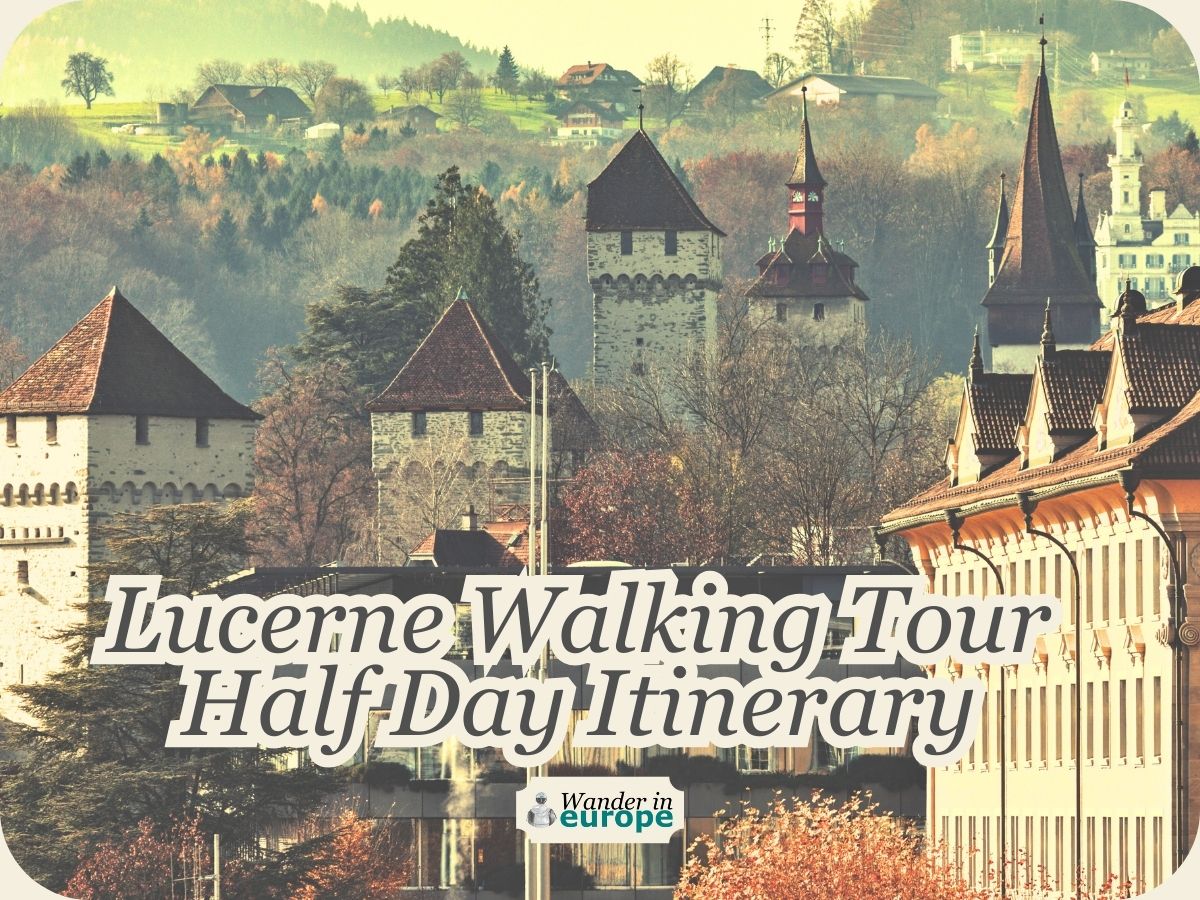
Subscribe to WanderInEurope’s Newsletter .
I’m sending you gifts — free travel itineraries and travel inspiration for your Europe trip. Can’t promise you’ll love everything, but it’ll definitely come in handy .
This post may contain affiliate links. I may receive a tiny commission at no additional cost to you from any qualifying purchases using the link.
Is it just me, or does anyone else love making spontaneous trips? I love wandering, and oftentimes it’s enough for me to enjoy the place I’m visiting.
As much as I hate planning, it seems necessary to meticulously prepare for a trip to Switzerland because it’s an expensive country to visit. We want to maximize every minute of our journey by visiting as many places as possible, without sacrificing the quality of our experience.
That’s what we aim to achieve in today’s post—to make your time in Lucerne’s old town maximized and worth it. We all also want a relaxing, leisurely trip, right?
So, perhaps we can start by answering the question, “how much time do you really need in Lucerne’s old town?”
There’s really no specific length of time required to spend in Lucerne’s old town, but you should at least allocate half a day to see its most iconic landmarks and unmissable tourist attractions. If you can at least be familiar with the routes and have an idea of what to do at each point of interest, I think you can have a laid-back journey in Lucerne’s old city.
Save to Pinterest
So, let’s now get into the details.
Summary: Half Day In Old Town Lucerne
For me, there are seven specific places in Lucerne’s old town that all travelers should see. They are:
- The Chapel Bridge — the most iconic landmark in Lucerne and Switzerland
- The Jesuit Church — an awe-inspiring architectural marvel
- Spreuer Bridge — a landmark with special artwork on its gable
- Musegg Wall — one of the best preserved intact medieval fortifications in all of Switzerland
- Lion Monument — a meaningful artwork and landmark, described by Mark Twain as “the most mournful and moving piece of stone in the world.”
- Hofkirche or the Church of Saint Leodegar — an eye-catching landmark, best to go for a selfie or a photo souvenir in Lucerne.
- Square(s) in the old town— the place(s) where you can find the beautiful little things in Lucerne.
Based on my estimates, you can see the top attractions in the old town of Lucerne in about 4 hours. About 3 hours will be spent visiting the actual sights, and the remaining time can be used for traveling between them within the old town.
Here are more details:
The tourist attractions listed above are in a sequence that, if you follow, you won’t be retracing your steps. Essentially, it follows a round trip path (assuming you will be arriving in Lucerne by train) from the train station to the Reuss River area, then the Musegg Wall, the eastern old town, the central old town, and back to the train station.
Below is a map showing their exact location and the route for this half-day Lucerne old town walking tour itinerary.
Their location in Google Maps is linked at the end of this post (resources).
Destinations Half Day Lucerne Walking Tour
For this part, you’ll get more ideas about the seven places I mentioned in the summary of the walking tour. You’ll learn what they are all about and why they are worth your time. The location and the unmissable experience/things you must see for each destination will also be discussed here.
Note that these destinations aren’t only landmarks and interesting places you will see along the route of this walking tour. Some of them are:
- Rathaus — is the town hall of Lucerne, a landmark with notable architecture and a clock tower. You can find it between the Chapel Bridge and the Jesuit Church .
- Historisches Museum Luzern & Natur-Museum Luzern — A nice place to visit if you want to learn more about the local history and flora & fauna in the region. They are just beside the Spreuer Bridge and are a nice alternative destination when there is bad weather.
- Glacier Garden — is a geological and botanical park that features a series of exposed rock formations and plant specimens from various geological periods. The rock formations were created during the Ice Age when glaciers covered the area and left behind a series of grooves and ridges in the rock. You can find it just beside the Lion Monument .
- The Bourbaki Panorama — is a circular painting located in a circular building, and it depicts the retreat of the French army during the Franco-Prussian War in 1871. The painting is over 100 meters in length and nearly 10 meters in height. You can find the panorama between the Lion Monument and Hofkirche .
I linked these tourist attractions’ official website in this post’s resources section. Okay! Let’s now talk about the seven must-see tourist attractions in Lucerne for your half-day walking tour.
Check out my other itineraries (and maps) about Lucerne. They should give you idea to enjoy Lucerne in different ways. You can read them here:
- Old Town Lucerne Map: 10+ Things To Do In Old Town Lucerne
- How To Spend One Day In Lucerne (1-Day Itinerary)
- Best Way To Spend Two Days In Lucerne (2-Day Itinerary)
- 10 Best Things To Do In Lucerne For Three Days Or More
Destination 1: Chapel Bridge
If you travel to see bucket list destinations (or the world’s greatest places), arriving in Lucerne by train means you can check one off your list right away.
That’s because of the Chapel Bridge, the most iconic landmark of Lucerne. You can literally see this bridge from the square in front of the train station, particularly in front of Torbogen (Archway) Luzern—the archway and the remaining part of Lucerne’s old train station.
The Chapel Bridge is the long wooden bridge that diagonally crosses the Reuss River. I mentioned that the Chapel Bridge is a bucket list tourist attraction because it is the world’s oldest surviving truss bridge and Europe’s oldest wooden covered bridge.
You should visit the Chapel Bridge because it’s indeed a unique and beautiful landmark, especially with the Water Tower that stands beside it. The Chapel Bridge also has special triangular gable paintings that depict the history of Lucerne. Surely, a visit to the Chapel Bridge will be an experience like no other!
If you like taking photos, the Chapel Bridge is the most compelling place to fill up your camera’s storage. That is especially true during warmer months when the Chapel Bridge is decorated with beautiful colorful flowers.
And oh, watch out for the lovely swans that linger below the bridge!
Read my full article about the Chapel Bridge , where I discuss everything you need to know when visiting it.
Destination 2: Jesuit Church
Jesuit Church is one of the landmarks in Lucerne that makes the view of the old town Lucerne with the Reuss River so lovely. Dominating the skyline with its twin onion-top towers, you should be able to see the Jesuit Church anywhere in the Reuss River.
So, what’s the Jesuit Church in Lucerne all about?
The Jesuit Church, like the Chapel Bridge, is a notable landmark in Lucerne because it is the first large baroque church that was constructed north of the Alps. It dates back to the 17th century, which is also the time when the Protestant church spread in Europe.
It was built with a baroque style, chosen in order to emphasize the traditions of Catholicism, particularly through its visual culture and the veneration of saints. Although it was primarily baroque, the most eye-catching features of it are its rococo embellishments in the interiors. That is the reason why I think you should visit the Jesuit Church.
For me, the Jesuit Church is an architectural gem, and it’s worth visiting for the grandiosity you’ll behold. For Catholics like me, the Jesuit Church has small chapels on the side where you can find artworks and relics of saints. I believe they can help you meditate and pray.
See what it is like inside the church and discover where you can photograph it from my post about the Jesuit Church .
Destination 3: Spreuer Bridge
Aside from the Chapel Bridge, the Spreuer Bridge is another covered wooden bridge you can find in Lucerne. It is the shorter version of the Chapel Bridge and has triangular gable paintings with a different theme.
Let’s say you are currently in Jesuitenplatz, the square in front of the Jesuit Church, then you can already spot the Spreuer Bridge. It is the second bridge next to Reussbrüke (the closest bridge) to the west.
I think you should visit the Spreuerbrüke because of the triangular paintings it has on its gables. These paintings are said to be one of the largest cycles of the painting depicting Danse Macabre. For me, they’re scary yet interesting artworks because they remind us of the truth that death can come at any point in our lives or to anyone, regardless of status and wealth.
A visit to Spreuerbrüke usually lasts only for a very few minutes. What may make it a little longer is the small chapel in the middle of the bridge. You may want to check its stained glass window and different figurines depicting biblical characters.
Destination 4: Musegg Wall
If you’re also a fan of movies/series set in the medieval ages like me, perhaps Musegg Wall will also be your favorite destination in Lucerne. It’s where your fantasies come to life, your imagination stimulated: scenes of soldiers marching, arrows flying, dragons breathing fire!
As its name suggests, Musegg Wall is a medieval fortification of the old town Lucerne in Musegg in the northern portion of the old city. Back in the day, it was a part of a 2-layer fortification that safeguarded the old city since the 14th century.
You should come and see Musegg Wall up close because it is an excellent example of medieval military architecture in Switzerland. Each of its 9 towers has its own unique style! Most importantly, Musegg Wall is the most preserved medieval wall in the country that still stands in one piece.
Of course, you wouldn’t want to miss a unique experience from Musegg Wall: climbing the towers and walking in the ramparts—a magical time transporting experience!
There are four towers open to the public. Among the four, you should at least try climbing Männliturm (the only tower with an open roof deck) and Zytturm (a mural-decorated clock tower with clockwork exhibits inside).
Do you want to see what’s inside Zytturm? Or what’s the view from the ramparts? Discover everything you need to know from my other post dedicated to Musegg Wall .
Note: The towers of Musegg Wall are open only during non-winter months. However, you can still check the wall through the hiking trails beside it.
Destination 5: Lion Monument
On the hilly east side of the old city, we can find the Lion Monument, another famous tourist attraction in Lucerne. Of the places that you’ll visit (following this itinerary), the Lion Monument is the newest that you will find. The monument was built in the early 19th century.
The Lion Monument is a memorial for the Swiss soldiers who perished while defending the last French Monarch during the French Revolution.
It is a very meaningful sculpture of a lion, full of emotion. You can see it on its face, which depicts excruciating pain—symbolic of the experience that the Swiss soldiers and their family members had.
I think the Lion Monument is unmissable for several reasons. Aside from being a meaningful landmark, it is also a beautiful work of art. It may not be so apparent in the photos, but the Lion Monument is gigantic!
Believe it or not, the Lion Monument is 10 meters long and 6 meters tall.
If you also love introspecting while you travel, the Lion Monument can be a fantastic place you can go within the city. The Main Lion monument is above a calming pond inside a park covered with trees. You can sit by the benches and reflect on the message that the monument implicitly represents: loyalty and bravery.
Learn more about the Lion Monument and the things you must know before coming from my other post.

Destination 6: Hofkirche
Hofkirche, or the Church of Saint Leodegar, is the most noticeable landmark in the old city when sightseeing from the shores of Lake Lucerne. Its pointed twin spires are an eye-catcher across the skyline of Lucerne.
Yet, indeed, Hofkirche is more than a landmark in Lucerne. It is a religious structure that has both historical and architectural significance. Although its original appearance is no more, it’s mind-blowing to think that this church has already been there for over a thousand years.
For architecture enthusiasts like me, Hofkirche’s most notable attribute is its mix of German renaissance and gothic styles. It’s a unique find, which I think is a reason why you must visit it.
You can already see its eclectic style before entering the church—right on its facade and main portal. Gorgeous reliefs, intricate murals, and beautiful wood crafts await you there. Those and the pointed spires make Hofkirche one of the best places in Lucerne to take selfies and capture photo souvenirs.
Aside from marveling at Hofkirche’s gorgeous facade, you may also come inside the church to see impressive altarpieces and wrought iron gates. Check what else you can find inside this church from my post about Hofkirche or the Church of Saint Leodegar .
Destination 7: Old City (Lunch or Dinner)
After hours in the bridges, walls, monuments, and churches of Lucerne’s old city, I’m sure you’ll be hungry. That’s why it’s only after you visit them that you must come to Lucerne’s central old town. It’s where you can find the best restaurants with alfresco seating, offering beautiful views of Lake Lucerne or Reuss River.
Not only will your tummies be satisfied, but also your eyes! Aside from the calming and scenic views of the lake and river, it’s here in the central part of the old city, you can find the most beautiful houses and fountains in Lucerne.
Have a look:
These beautiful artworks you can find on the facades of the houses in the old town of Lucerne are called Lüftlmalerei. As far as I know, they are cultural art originating from Bavaria and Austria. It is the same with the fountains in the city.
Lüftlmalerei usually depicts the favorite saints and the occupation of the house owners. Sometimes, they just serve as decorative ornamentation. Regardless of what this Lüftlmalerei depicts, it is one of the beautiful things you can find in Lucerne that will fascinate you as you explore the city.
You don’t have to worry about where these houses and beautiful fountains are in Lucerne’s old town. They are located in the old town’s squares like Hirschenplatz, Sternenplatz, Weinmarkt and Kornmarkt.
Here is the map to guide you to find them:
What To Do Before Or After The Half Day Walking Tour?
So, that’s it! That’s how you can efficiently explore Lucerne’s Old Town on foot in a few hours or half a day.
Since the walking tour can be completed within a few hours, you may still have a lot of spare time in Lucerne if you plan to stay in the city for a day or two. If you need ideas on where to go or what to do to fill that time, I have five suggestions for you:
If you need more relaxation after l strolling in the Lucerne old town for a few hours, perhaps it might be the boat you need. For a special experience, try not the ordinary boat tour but the 1-Hour Cruise on a Panoramic Yacht instead.
During the 1-Hour Cruise on the Panoramic Yacht in Lake Lucerne, you’ll marvel at the picturesque landscapes and famous attractions this region has to offer.
You’ll experience the beauty of the lake from a unique perspective as you sit on the water terrace suspended above the surface. Relax on the upper deck with an adjustable roof, where you can take in the fresh air and sunshine while enjoying a multi-sensory experience in nature.
As you cruise along the lake, you’ll have a personal audio guide to give you insights into Lake Lucerne and its rich history. It’s a unique way to discover new things as you’ll be, at the same time, taking in the stunning mountain views and charming towns and villages that line the shores.
With the peaceful surroundings, you’ll surely be transported to a world of relaxation and tranquility. You can learn more about the 1-Hour Cruise on the Panoramic Yacht in Lake Lucerne here.
Swiss Museum Of Transport
In the Swiss Museum of Transport in Lucerne, you can unravel the fascinating history behind all forms of travel. From road, rail, and water up to the air, this museum covers it all.
Step inside and discover an array of exhibits and interactive displays that explore the evolution of transportation over the years. Learn about the advancements and innovations that have shaped how we move from place to place, and see a wide range of vehicles and artifacts up close.
For a sweet and memorable experience, take a ride on the Swiss Chocolate Adventure, where you can catch glimpses of the chocolate-making process and get sweet treats from master chocolatiers.
In addition to the exhibits, the museum also has a Film Theatre and a Planetarium, where you can catch daily screenings of numerous educational films.
Make the most of your visit with a day pass , which allows you to immerse yourself in a fully interactive experience at the Swiss Museum of Transport.
Hammetschwand Elevator
Did you know that the Chapel Bridge isn’t the only bucket list destination around Lake Lucerne? Another is the Hammetschwand elevator—the highest exterior elevator in Europe.
Hammetschwand Elevator is located on the Bürgenstock plateau, directly opposite the city of Lucerne across Lake Lucerne. On the top of the elevator, visitors are rewarded with stunning views of Lake Lucerne, Lucerne, and the Central Plateau.
This elevator is often visited on a day trip to Bürgenstock resort, where you can find scenic hiking trails, ride funicular trains, and dine in fancy restaurants having a wide selection of international cuisine. Going to Bürgenstock resort involves a round-trip boat ride across lake Lucerne, as well.
If you are interested in visiting Hammetschwand Elevator and Bürgenstock resort? Check out this tour package to Mount Bürgenstock by Ferry and Funicular .
- Meggenhorn Castle
Like most lakes in the Alps, Lake Lucerne also has castles and beautiful villas. If you want to see a magical scene of the Swiss countryside before/after the half-day tour, these castles are the place to be.
Imagine a place where you can see a castle, lake, and mountains combined together—it’s a scene straight out of a fairy tale, isn’t it?
Let’s say you’re already in Lucerne, and you just finished the walking tour. Wherever you are in the old city, you are now less than an hour from Meggenhorn Castle.
It’s one of the castles on the shores of Lake Lucerne. And as described, it’s a magical place—we can consider it a hidden gem in Lucerne.
A hidden gem because only a few tourists know Meggenhorn Castle. (You can learn more about the Meggenhorn Castle and the route to this castle from the links in the sources section of this post)
But in a nutshell, Meggenhorn Castle is a 19th-century castle perched on a peninsula overlooking views of Lake Lucerne and has a panorama that includes Mount Rigi, Mount Pilatus, and the city of Lucerne. It’s an ultimately picturesque place, and I think you’d not regret coming there, particularly if you come during warmer, sunny months.
You can get to Meggenhorn Castle with a single bus ride (bus #24) from Lucerne train station and hike for 15 minutes.
But if you want, you can join a tour of Meggenhorn Castle. It’s a 4-hour trip, perfect before and after the half-day old town Lucerne tour. It includes visiting a 14th-century settlement in Lucerne, seeing old chalets, and more. Learn more about Lucerne Lakeside and Villa Private Walking Tour here .
Mount Pilatus
Mount Pilatus is another destination in Switzerland that “ may” match your schedule with the half-day walking tour in Lucerne’s old town. However, to fully enjoy it, you must visit it on a laid-back day trip. This is why I don’t fully recommend it.
Learn more about Mount Pilatus and the 5 reasons why it’s a nice day trip from Lucerne .
Do you need more ideas where to go in Lucerne? I can help you with that! You can try reading: 10 Must-See Landmarks In Lucerne (Free Things To Do) , 10 Unique Things To Do In Lucerne and Lucerne Is A Beautiful City: 10 Beautiful Things To See . (Links open in a new tab)
Sources: Walking Tour In Lucerne
- Historisches Museum Luzern
- Natur-Museum Luzern
- Glacier Garden
- Bourbaki Panorama
- Route to Meggenhorn Castle
- Chapel Bridge (Google Maps)
- Jesuit Church (Google Maps)
- Spreuer Bridge (Google Maps)
- Musegg Wall (Google Maps)
- Lion Monument (Google Maps)
- Hofkirche (Google Maps)
Looking for different ways to travel in Switzerland? Check my itineraries below.
4 Days Switzerland Itinerary: Visit Lucerne and Bern
6 Days In Switzerland Itinerary: Bern, Interlaken, and Thun
Leave a Reply Cancel reply
Your email address will not be published. Required fields are marked *
Save my name, email, and website in this browser for the next time I comment.
Best Walking Tours In Lucerne (Unmissable Experiences)

Lucerne is one of the loveliest cities to visit in Switzerland and deserves a spot at the top of your European dream destinations. Imagine an Old Town with colorful facades and paintings that tell the story of the family who first lived there, a 14th-century rampart wall, and a covered wooden bridge built in 1333!
Lucerne is connected to all of Europe and Switzerland’s major railways making it easy to visit. This Swiss city is full of history and stories to be heard. One of the best ways to experience both the history and the many things to do in Lucerne is with a walking tour by a local guide like one of the following.
Table of Contents
Lucerne 2-Hour Guided Walking Tour

Find out why Lucerne is called The City of Lights and other interesting facts about the city on this informative and entertaining 2-hour walking tour . You’ll meet your guide at the Tourist Information Luzern shop and head out to see the Chapel Bridge and water tower, the Spreuer Bridge, and the iconic Museggmauer city wall.
You will get to admire the historical facades of ancient buildings in the old town as well as Lucerne’s more modern Culture and Congress building. All of this fantastic sightseeing is embellished with historical and often amusing tales about Lucerne.
Lucerne: 1-Hour Historical Tour with Night Watchman

Discover the City of Lights with a night watchman as your guide on this fascinating 1-hour historical tour . Hear stories about life in the Middle Ages from law and order to war and Swiss mercenaries and much more. You’ll be amazed at how much this short tour covers. Topics include Hans von Trient and his nemesis Luzius Ritter, the engraver Martin Martini, and other past Lucerne personalities.
This tour also takes you by some interesting landmarks as they tie into the narration. It begins near the Chapel Bridge and goes to Kapellplatz, then along Furrengasse to Kornmarkt.
Lucerne: Culture & Congress Centre Behind the Scenes Tour

Get a behind-the-scenes look at the Lucerne Culture & Congress Center on this unique tour . Known to the locals as KKL Luzern, this amazing concert hall is highly regarded as the world’s best. Learn about the archeological vision of its creator, Jean Nouvel, and how the concert hall came into being.
A knowledgeable tour guide will explain the fascinating features of the KKL including its perfect proportions, echo chamber, and sound reflector.
The meeting point for this tour is the KKL lobby.
Lucerne: Private Walking Tour with a Local Guide

See the city like a local on this private tour with a local guide. You’ll see the main sights of the city and discover hidden gems as well. Highlights include the Chapel Bridge, the Museggmauer Wall, and more. All of the best parts of Lucerne are the focus of this tour. Guides are willing to customize your tour and answer questions about how best to spend your time in Lucerne.
This is your chance to get the inside scoop about where to go and what to do in Lucerne. A favorite feature of this private tour is that it includes hotel pick-up.
Private Medieval Walk in the Historic Centre of Lucerne
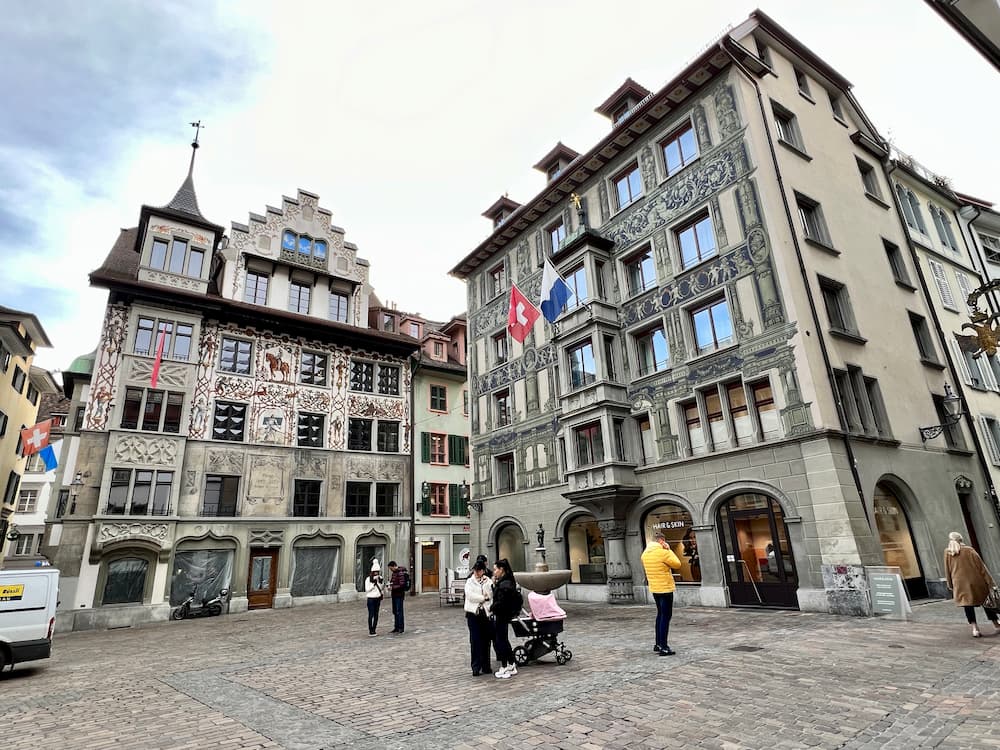
This tour will take you back to how Lucerne looked 500 years ago through the eyes of the nightwatchman. A unique feature of the tour is following along with a presentation through words and pictures on your mobile device.
Once you meet your guide at the Chapel Bridge, you’ll listen to commentary about life, society, and notable people from the medieval era. The stories continue as you follow a route that includes the Kapellplatz, the Furrengasse, Kornmarkt, and Weinmarkt.
Express Walk of Lucerne with a Local
This 1-hour experience introduces you to the City of Lights in a nutshell. Led by a local, it’s a quick yet thorough overview of the city’s highlights and history. You’ll meet your group in front of the LUZ bistro near the Tourbogen and take a guided walking tour of the city center.
Have a list of questions to ask? Your tour guide can answer your questions from a local’s perspective. Get insider tips on the best places to eat and drink.
Lucerne Classic City Walking Tour

This classic tour is one of the most comprehensive you’ll find in Lucerne. The guide will meet you at your hotel’s reception and explain your route on a city map before departing for the Bourbaki Museum for a history lesson. The next stop is the Lion Monument which commemorates Swiss mercenaries.
From here you’ll continue to explore Lucerene’s highlights and hidden gems. You’ll climb the hill to the Musegg Wall, visit the Peterskapelle (the city’s first church), and more before ending with a stroll across the Chapel Bridge.
Lucerne: 3-Hour Essential Photography Tour

This intensive 3-hour tour will ensure that you go home with the best possible photos of your trip. The city has many photographic possibilities from iconic landmarks to interesting back streets and cultural experiences. Your tour guide and a professional photographer will help you capture great images of modern and historical sights.
You’ll go to the Musegg Wall, the Chapel Bridge, the dramatic Lion Monument, the KKL, and more.
The meeting point for this tour is Torbogen Luzern, Bahnhofplatz.
Lucerne: Water Tower Ticket with Private Guided Tour
This specialized tour gives you an in-depth look at Lucerne’s old water tower by the Chapel Bridge. A knowledgeable guide will meet you in front of the Lucerne train station with narration on the story of the Middle Ages in Switzerland. Once at the tower, you’ll get to explore sections of the tower like the dungeon, the Armory, and the treasure chamber.
After learning the dark secrets of the tower, you’ll get to go to the top for a view of the city and its surroundings. You’ll have the option of extending the tour with snacks and drinks.
Lucerne Walking and Boat Tour: The Best Swiss Experience

Lucerne’s Old Town and history are fascinating but don’t overlook Lake Lucerne, Switzerland’s 5th largest lake. This tour has you covered with a small-group tour of the city on foot and a sightseeing boat ride on the lake. The tour lasts for 3 hours and includes landmarks like the Chapel Bridge and other archeological gems and monuments.
You can also get the option of a wine tasting with Swiss cheese. Depending on your options, you’ll either meet at the Big Arch in front of the train station or at the Torbogen Monument.
Meeting Points for Lucerne Walking Tours
Frequently Asked Questions
Is lucerne a walkable city.
Lucerne’s town center is easily explored on foot.
Is it worth going on a walking tour in Lucerne?
Lucerne is a city with a fascinating history and well worth the cost of a walking tour.
Leave a Reply Cancel reply
Your email address will not be published. Required fields are marked *
Get Our Free Swiss Tips Guide
Popular destinations, important pages, on social media, travel planning, certified swiss travel expert.

- You are here:
- Switzerland
Gotthard Panorama Express, a photo review
Self-guided walking tour of lucerne, switzerland.
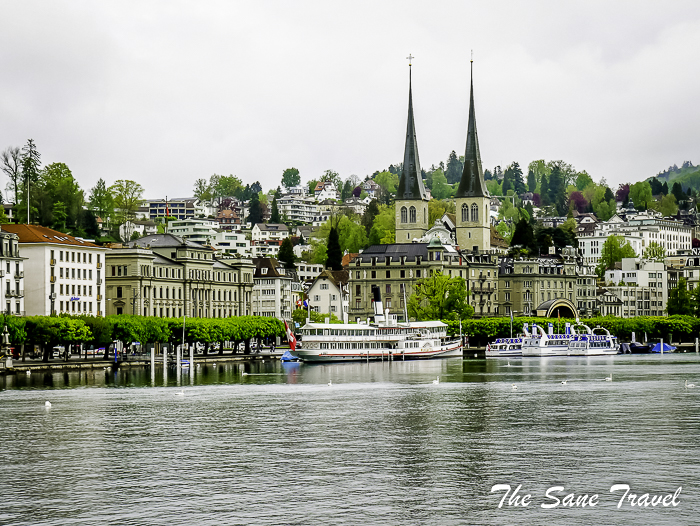
When visiting Lucerne, you will soon notice its blue and white flag. The symbolism of the blue and white is lost to history, but in modern popular culture, the blue represents lakes and the white represents snow-capped mountains. If you are using public transport to get to Lucerne, most likely you will arrive at Lucerne train station. So start your self-guided city walking tour from there.
Lucerne train station
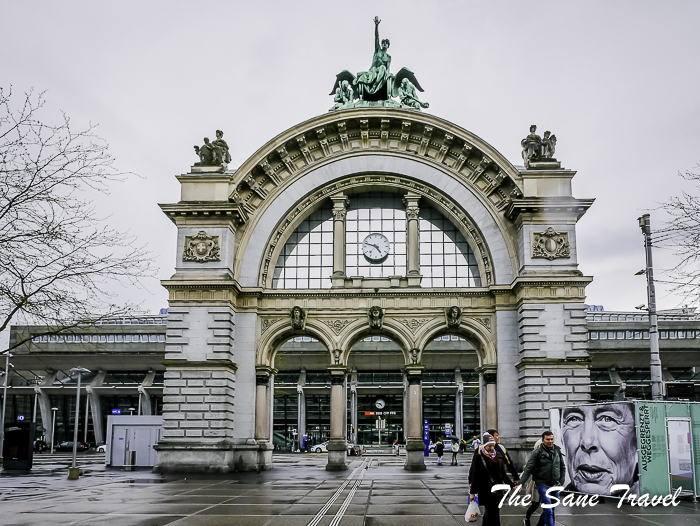
Lucerne Lake
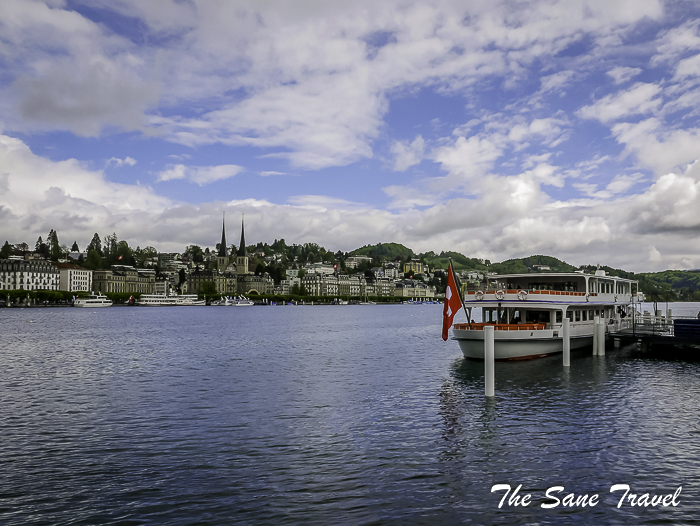
Chapel Bridge
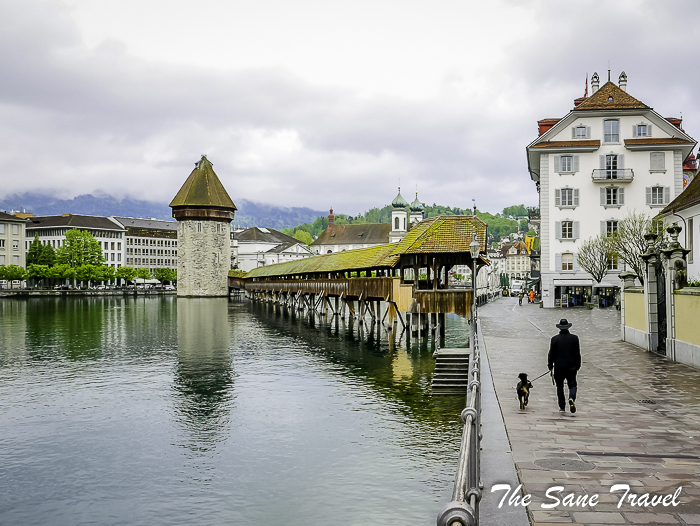
Lucerne Town Hall
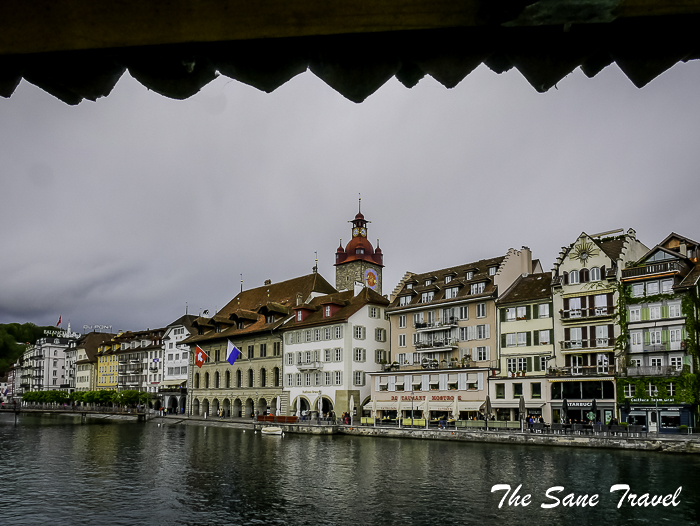
Jesuit Church
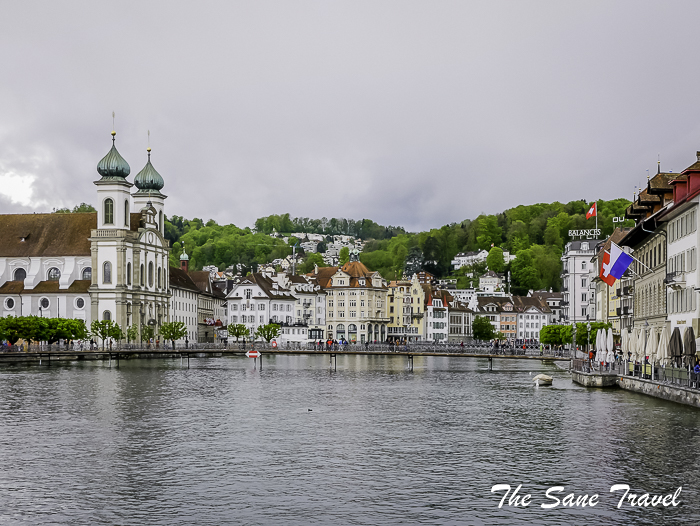
Spreuer Bridge
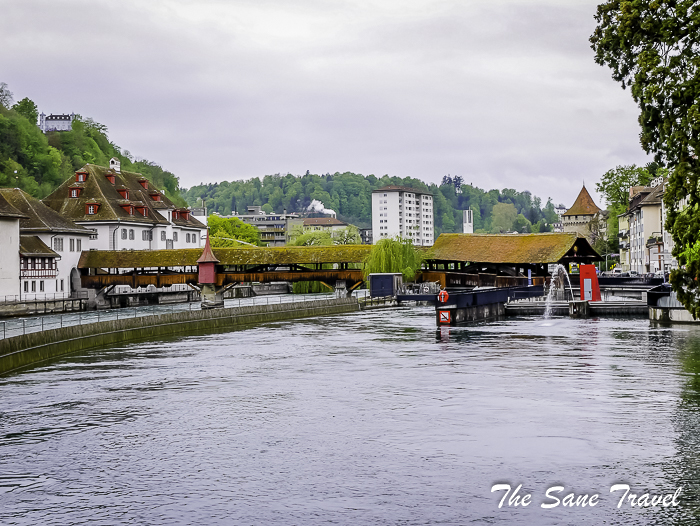
Musegg wall and its nine towers
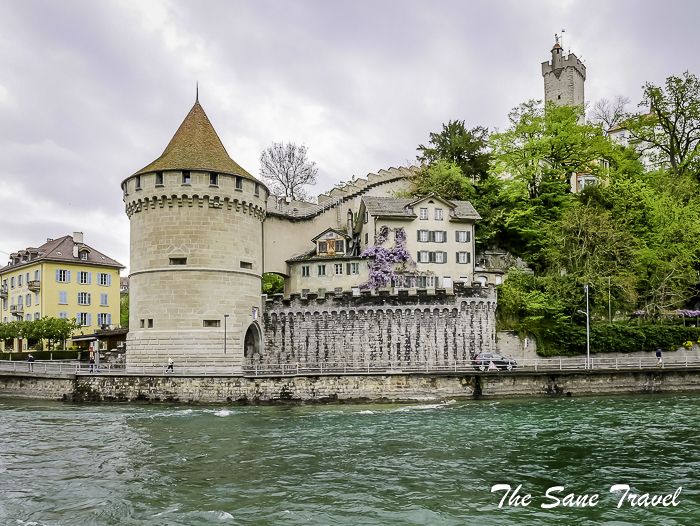
The Dying Lion of Lucerne
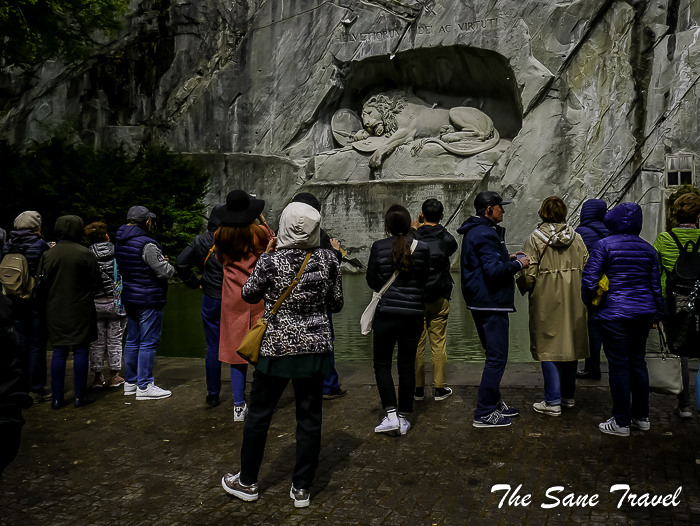
The Bourbaki Panorama
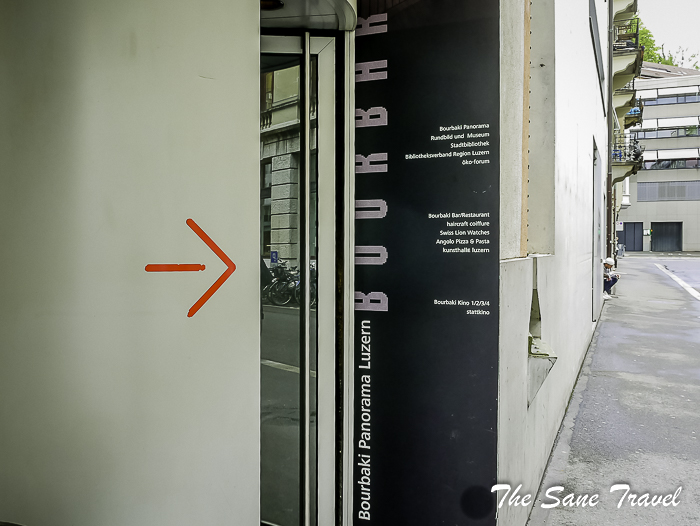
Address: St. Leodegarstrasse 6.
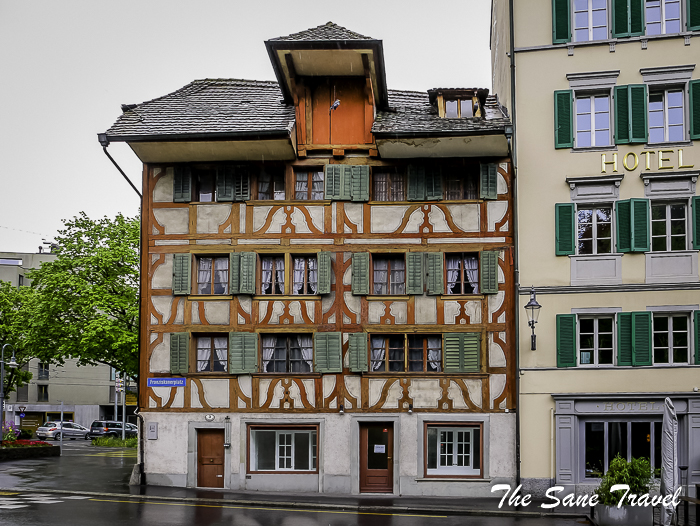
Address: Franciskanerplatz 3 Restaurant Fritschi building The colourful frescoed building in the heart of the old town dates back to the early 17th century. The impressive painting is a replica fitting to the restaurant inside. The rustic decor with carnival masks on the walls represents how a visitor may perceive the Lucerne of old. The restaurant name refers to the legend of brother Fritschi who left some money to the Safran guild on condition that during the carnival they serve wine to the poor for free.
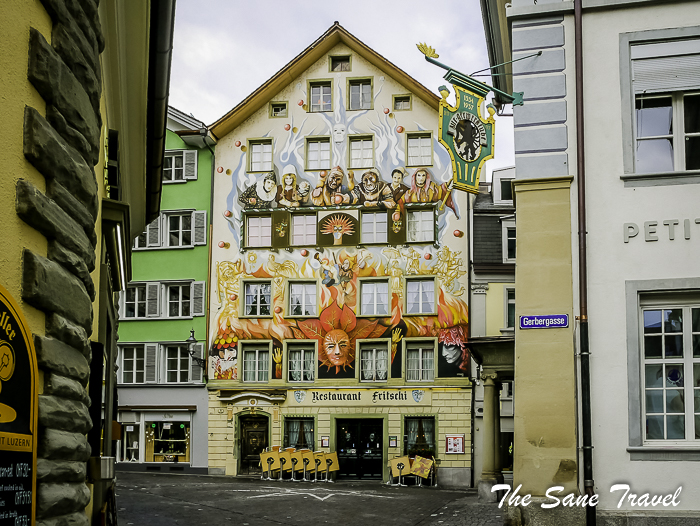
Practical information
Lucerne is close to Zurich airport with good train connection. You can reach it in about one hour from there. The rail station is at a walking distance from the beautiful old town center. If you stay overnight, get your free visitor card to Lucerne from your accommodation. Once you have received the link from your hotel, you can download your personal digital Visitor Card to your smartphone or print it out. The Visitor Card gives you free use of buses and trains within zone 10 of the city network, as well as a range of discounts for cableways, mountain railways, museums and excursions in the Lucerne Region. You can also take advantage of ‘Free WiFi – LUZERN.COM’ hotspots around the city.
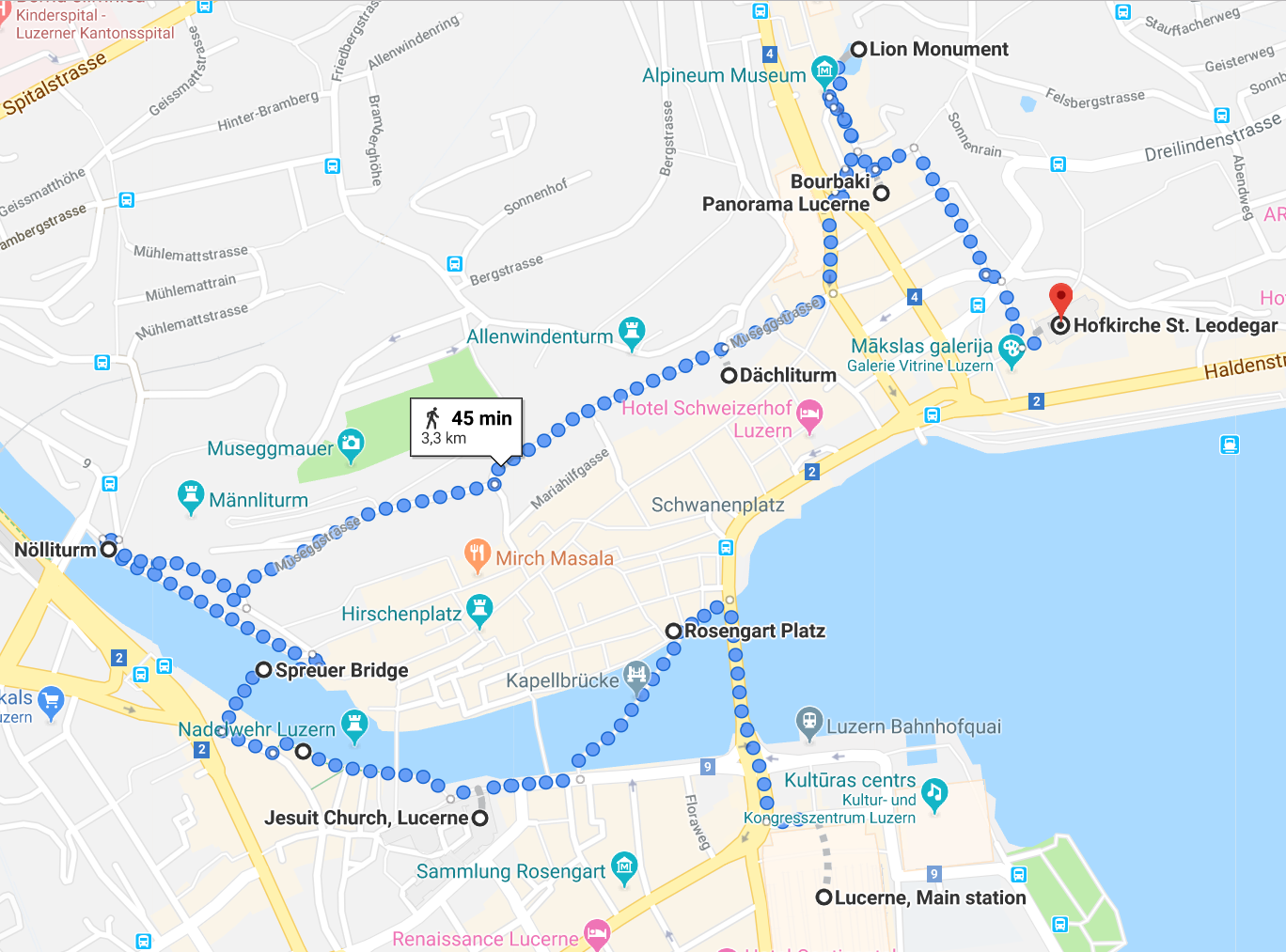
What did you think? Have you been to Lucerne? Or perhaps you’re thinking of visiting there in the near future? Either way, I’d love to hear from you so please add your comments below.
- Published by Anita on May 10, 2019
Author: Anita Sane
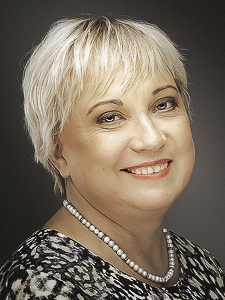
About the author Anita is a part-time traveller, passionate photographer and a retired career woman from Latvia, travelling mostly solo for more than 15 years. She is a skilled travel planner who plans and executes her travels by herself. Anita wants to show you how to travel the world and open your mind to new experiences. Follow her on Facebook , Instagram , Pinterest , Twitter and Bloglovin .
1000 Characters left
My comments
Related articles, stanserhorn, the great day trip from lucerne, best things to do in zurich.
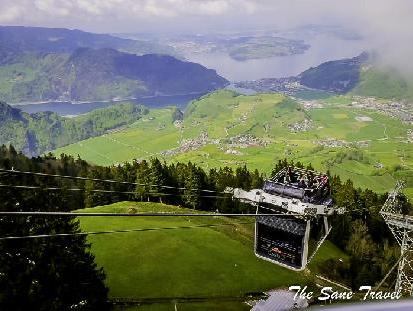
Lucerne in Switzerland is awesome by itself and because of its location, it’s an excellent starting point for many trips around Switzerland, including…
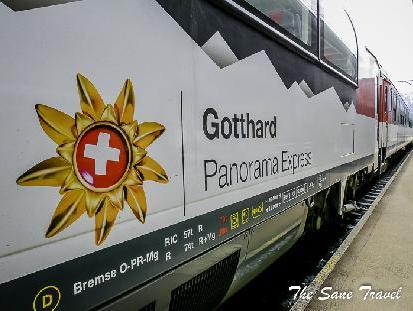
When planning your Switzerland holidays, think about adding a train tour to it. Switzerland is a great place for scenic train rides, with many options…
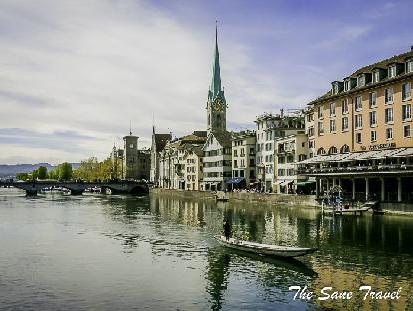
If you are heading to Switzerland, it’s very likely that your trip to this country will start at Zurich airport or train station. Zürich is the largest…
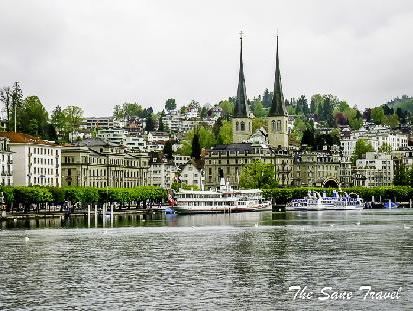
Lucerne in Switzerland also known by local German name as Luzern located at the Lucerne Lake and on the river Reuss is a compact, lively town. There are…
- Contacting me
- My travel wishlist
- The Liebster award
- New Zealand
- United Arab Emirates
- Window seat please!
- The Netherlands
- The Philippines
- United Kingdom
- United States
- Plan your own trip
- Travel light
- Helpful websites
- Great Britain

Travel Guide
- Things to Do
- Best Hotels
- Things to See
- Best Restaurants
- Best Nightlife
- Walking Tours
- Planning a Trip
Walking Tours in Lucerne
Start : Schwanenplatz.
Finish : Kurplatz.
Time : 2 1/2 Hours.
Best Times : Any Sunny Day.
Worst Times : Rush Hours, Monday to Friday from 8 to 9am and 5 to 6pm.
The best way to see Lucerne is on foot, going along its lakeside quays, across its old squares, and through the streets of its Old Town.
Start in the heart of Lucerne at:
1. Schwanenplatz
Translated as Swan Square, it lies on the north bank of the Reuss River and is reached by crossing the bridge, the Seebrücke, from Bahnhofplatz on the south bank, site of the train station.
Adjoining the square on the west is:
2. Kapellplatz
This is the site of St. Peter's Church. The church, the oldest in Lucerne, was built in 1178. In the center of the square is a fountain commemorating Carnival revelry in Lucerne.
From here, continue west along a major shopping street, Kapellgasse, until you reach the:
3. Kornmarkt
This is the old Grain Exchange or Corn Market, which is today the site of the:
4. Altes Rathaus (Old Town Hall)
A Renaissance building from 1602, the town hall has impressive masonry, a tremendous roof, and a tall rectangular tower. The tower is a good vantage point from which to survey the crowded market scene on Tuesday and Saturday mornings.
To the left of the town hall is the:
5. Rosengart Haus
This 17th-century building houses some Picassos from the Rosengart collection. The town house is entered at Furrengasse 21.
After leaving the museum, follow Rathausquai east toward Schwanenplatz again, but only to cross the:
6. Kapellbrücke (Chapel Bridge)
The symbol of Lucerne, this covered wooden footbridge crosses the Reuss River, leading to the south bank. Built in 1333, the bridge is 170m (558 ft.) long and crosses the river diagonally. It's one of the best-preserved wooden bridges in Switzerland, used originally for defense. There's also an octagonal Wasserturm (Water Tower), used variously as a prison, a torture chamber, and an archive. The bridge was always known for its 122 paintings that hung from its arched roof. Some of them were done in 1599 by Heinrich Wagmann, illustrating the daily activities and dress of the people. The bridge was damaged in a fire in 1993 and two-thirds of the original paintings were destroyed or severely damaged. Lucerne city officials directed that copies be made. After a $2.1-million reconstruction, this landmark bridge was reopened in the spring of 1994.
You emerge onto Bahnhofstrasse; you can continue right (west) until you see the next covered bridge across the Reuss, the:
7. Spreuerbrücke (Mills Bridge)
Built in 1407 and restored in the 19th century, this wooden bridge spans an arm of the Reuss. Its gables are painted with the Dance of Death, a mural by Kaspar Meglinger dating from the 17th century. The mural commemorates a plague that swept through the city.
Cross the bridge and take a sharp right to reach:
8. Mühlenplatz (Mills Square)
This square dates from the 16th century. This was the old site of Lucerne markets.
From Mühlenplatz, walk down Kramgasse (to the east) to reach the:
9. Weinmarkt (Wine Market)
Here you'll find a lovely old square with a fountain, west of Kornmarkt. Long ago the mystery play Confraternity of the Crown of Thorns was performed here. Among the colorful old dwellings on the square is the Müllersche Apotheke, a "drugstore" from 1530.
Directly northeast of the Weinmarkt lies:
10. Hirschenplatz (Stag Square)
Another landmark square of Lucerne, it's filled with restored buildings, many of them with painted facades and wrought-iron signs. In 1779, Goethe stayed at the Goldener Adler, which is located here.
From Hirschenplatz, head east along Weggisgasse, which opens eventually onto Falkenplatz. From Falkenplatz, continue east along Hertensteinstrasse until you come to Löwenplatz. This is the site of:
11. Panorama
Panorama is one of the largest canvases in Europe, covering 1,009 sq. m (10,861 sq. ft.) and curving in a circle around a central platform. Painted in 1889 by Edouard Castres and contained in a round building that was designed especially for it, it depicts the bloody retreat of the French army into Switzerland during the Franco-Prussian War.
The next stop on this tour is not immediately visible from Löwenplatz, but requires a brief detour north along Denkmalstrasse. Within about a block of Löwenplatz, high above your head, you'll see one of the most famous statues in Switzerland, the:
12. Löwendenkmal (Lion Monument)
Carved in deep relief into the sandstone cliff above the town, the monument is an allegorical reference to the bravery of the Swiss Guards who died in the Tuileries of Paris in 1792 trying to save the life and honor of Marie Antoinette. During his grand tour of Europe, Mark Twain called the "Dying Lion" of Lucerne "the saddest and most poignant piece of rock in the world." Designed by the great Danish sculptor Bertel Thorvaldsen, the statue was dedicated in 1821.
Retrace your steps back to Löwenplatz, then head south along Löwenstrasse all the way to the lake and Kurplatz, a few steps east of Schwanenplatz, the site of the:
13. Kursaal
This spot is a casino-and-restaurant complex on Kurplatz on Nationalquai.
Above Nationalquai, view the twin towers of the Catholic:
14. Hofkirche (Collegiate Church of St. Leodegar)
Named after the patron saint of Lucerne, this is the most important church in the city. There was once a monastery at this site, but the present Gothic-Renaissance building dates from the 17th century. The interior has rich wrought-iron work, carvings, and a famous organ from 1640, with 4,950 pipes. Concerts are presented in the summer. The church also has a beautiful courtyard with arcades.
A good way to end the tour, you are now standing at:
15. Kurplatz
From here, you can take in the best view of the lake from its northern rim. You can also take steamers from this area to visit various resorts along the lake. The view from here encompasses not only the lake, but also the Alps from Rigi to Pilatus. The quays are lined with trees, hotels, and shops, ideal for exploring on foot. At the end of the promenade is the lido, called Lucerne's "Riviera."
Note : This information was accurate when it was published, but can change without notice. Please be sure to confirm all rates and details directly with the companies in question before planning your trip.

- All Regions
- Australia & South Pacific
- Caribbean & Atlantic
- Central & South America
- Middle East & Africa
- North America
- Washington, D.C.
- San Francisco
- New York City
- Los Angeles
- Arts & Culture
- Beach & Water Sports
- Local Experiences
- Food & Drink
- Outdoor & Adventure
- National Parks
- Winter Sports
- Travelers with Disabilities
- Family & Kids
- All Slideshows
- Hotel Deals
- Car Rentals
- Flight Alerts
- Credit Cards & Loyalty Points
- Cruise News
- Entry Requirements & Customs
- Car, Bus, Rail News
- Money & Fees
- Health, Insurance, Security
- Packing & Luggage
- -Arthur Frommer Online
- -Passportable
- Road Trip Guides
- Alaska Made Easy
- Great Vacation Ideas in the U.S.A.
- Best of the Caribbean
- Best of Mexico
- Cruise Inspiration
- Best Places to Go 2024
The Revolving Compass
To share our love for travel….countless soul enriching experiences
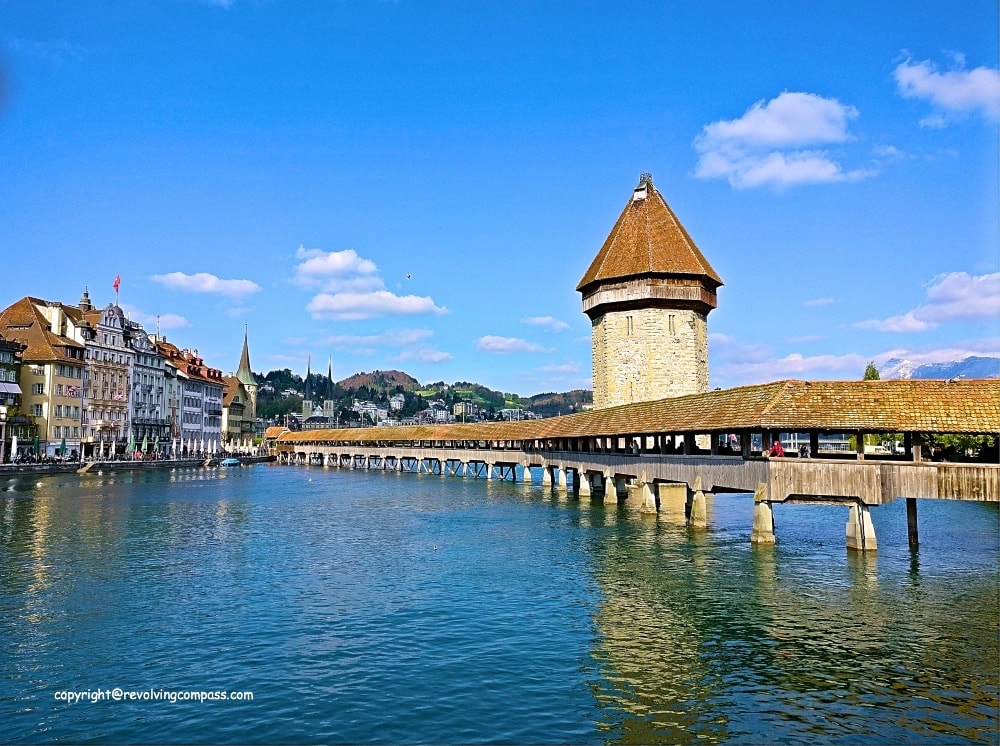
A free lucerne city walking tour
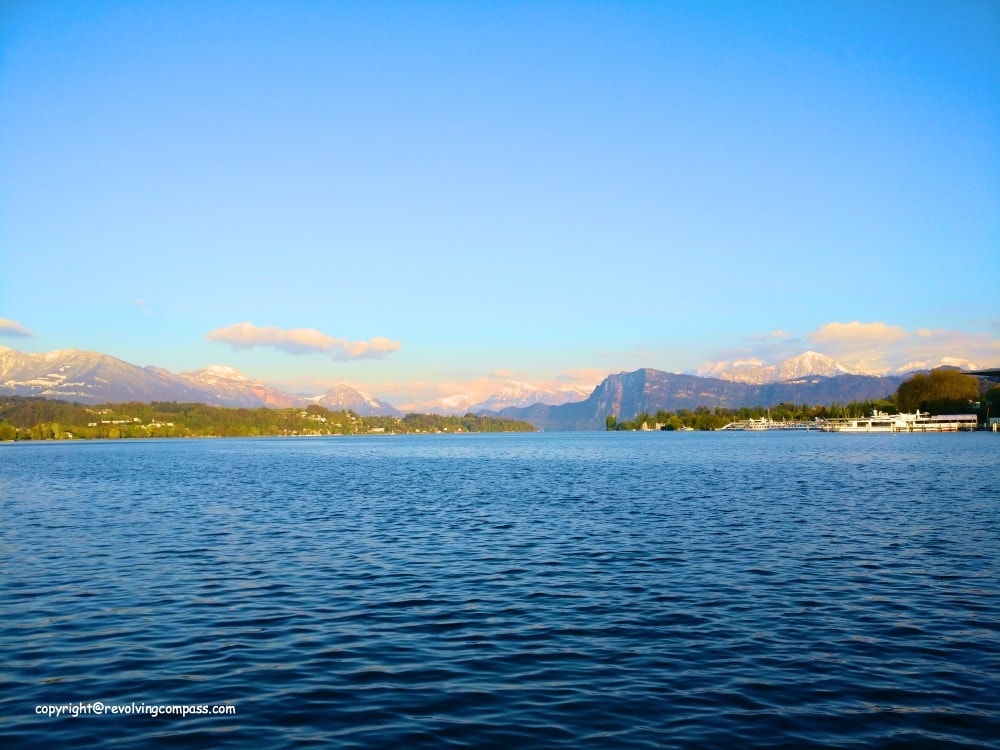
Self walking tour have been one of the most important aspects of our 2 weeks Europe trip itinerary. in 2017 . And we urge everyone to explore Europe through similar self walking tours. Since someone said it right – Europe is best explored on foot. You might have already walked with us on our free self planned and self guided walking tour of Florence across the river Arno and yet another one exploring the heart of the renaissance capital . Then there was a walking tour that we took in Venice . And now, we are ready to take you with us on yet another beautiful walking tour – a free Lucerne city walking tour.
This is almost a half day walking tour that we took on the day of our arrival in Lucerne.In case you are pressed by time, try this 1 hour express tour or, this 2 hours walking tour instead. Also, a recent super fast and eco friendly way to explore the town is this e-tuktuk tour . Which is also highly suitable for elderly and kids. And if you prefer guided tours, we highly recommend booking this extremely small group guided tour for the best experience.
Again, ours is a free walking tour, with a map from our hotel Hotel Drei Konige, Luzern to the important spots of Lucerne city, in order. There is a map at the end of the article to help you visualize. You can as well replace any of these points with yours. And if required, rearrange the stops a little bit. After that, you will be ready with your own map. Without further delay, let’s start the walking tour.
Table of Contents
Jesuit Church
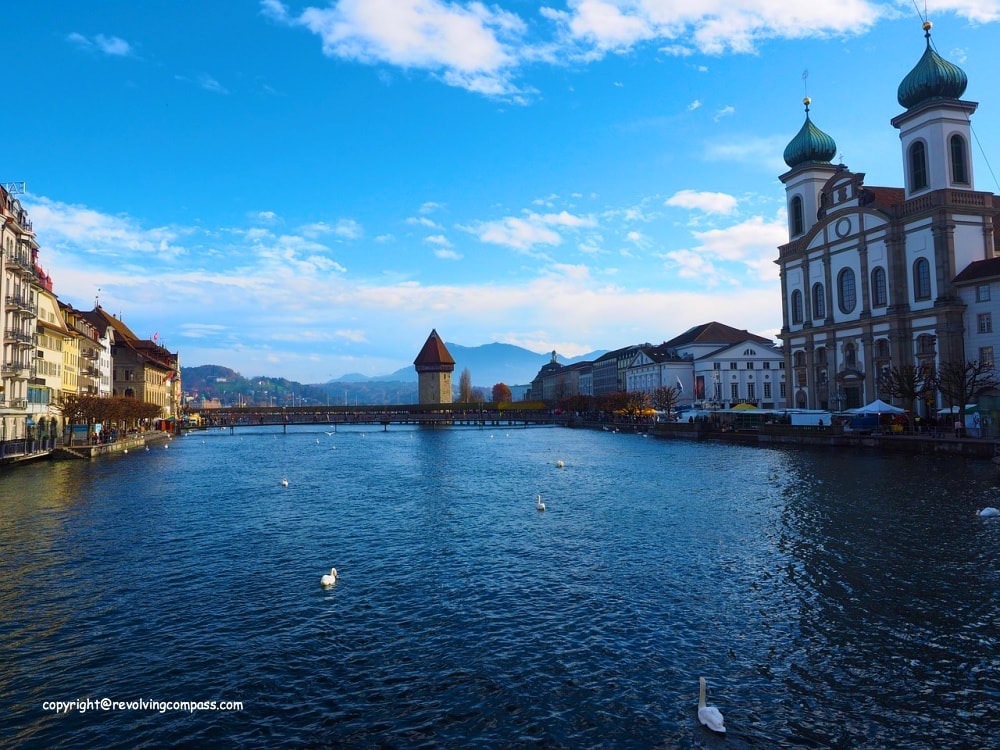
Jesuit Church is the first large baroque church built in Switzerland north of the Alps. Since, this was the spot nearest to our hotel, we decided to start our free Lucerne city walking tour from here. Walking just 5 minutes from our hotel, we arrived at the Jesuit Church. The church boasts of beautiful architecture both from outside and inside. And the premises are huge and you can see other buildings nearby where those in the service of the Church must be residing. There is a beautiful fountain in a lawn near the Church where we refilled our water bottles before embarking further on our free Lucerne city walking tour.
Banks of Lake Lucerne
From Jesuit Church, we started walking towards our next stop – Chapel Bridge . But, first we approached the banks of Lake Lucerne, just before the Chapel bridge. There are steps here that lead to the lake. And we sat on these steps. Our little one was immediately captivated by the ducks and swans that were enjoying the pristine lake. The beautiful blue water was producing small waves. And we could clearly see through the water to the bed of the lake and the brown rocks and pebbles lying there. A couple of families came around and fed the ducks and swans some bread. While we watched the scenic beauty of Lucerne across the lake, absolutely captivated by it’s charm.
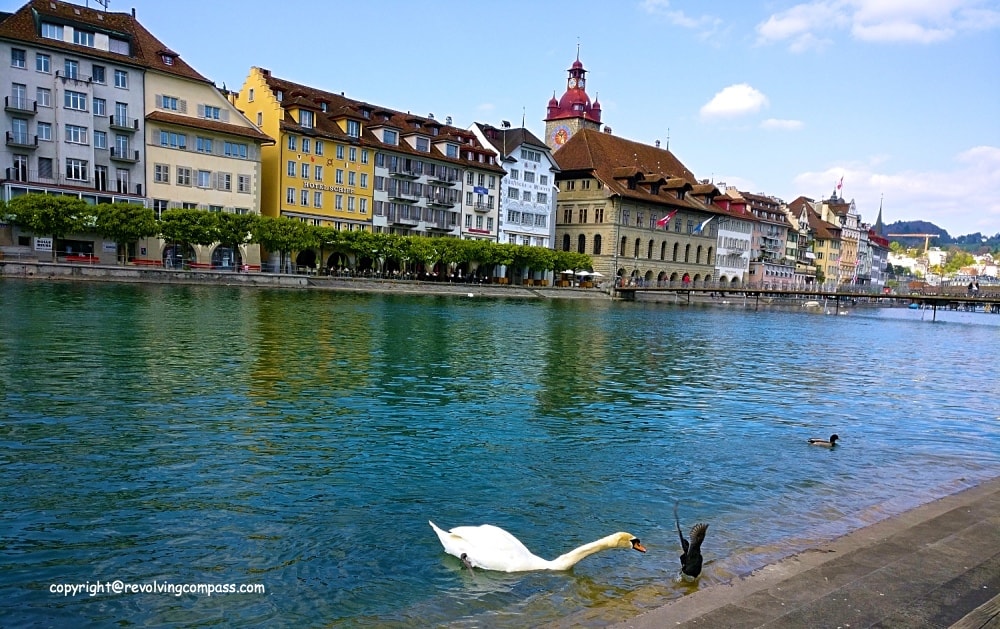
When we were ready to get back on our feet after some time, the little one was not at all ready. She wanted to sit on those banks till eternity and watch the ducks and swans hypnotically 😀 . It took some effort to make her leave the beautiful bank and walk towards the Chapel bridge itself to cross the lake. We vowed to return back here some day towards evening. Because we were sure when the street lights come up at night, and they produce a reflection into the lake, it will be a scene to behold. And we were absolutely right. We did return here on our last day in Lucerne. And we must have been disappointed had we missed the scene that we saw.
Chapel bridge
Walking further, we arrived at the Chapel bridge. It is an old wooden bridge across lake Lucerne that has been preserved well along with it’s rustic charm. When you are in Lucerne, you have got to walk across this bridge at least once. Don’t forget to stop in the middle of the bridge and admire the scenic beauty that lies on both the sides of the bridge. Indeed, Switzerland has been created by the Almighty with the most exotic resources that he had at hand. Walking slowly through the Chapel bridge, admiring the beauty of the surroundings and stopping once in a while to rest our foot, we proceeded further on our free Lucerne city walking tour, to arrive at the other end of the Lake.

Lake Lucerne
The largest, bluest, and most pristine lake that I have ever seen in my life so far is what I can say to define Lake Lucerne. Although I had always imagined it to be similar to one of the high altitude lakes in Indian Himalayas , but it turned out to be very different. And one of its kind. Dotted with ducks and swans, it is so crystal clear that you can see till the bottom of the lake. Although narrow in the middle of the town, it tends to quickly get wider as you walk further along it’s bank. There are several boats, yacht and cruise ships available to explore the lake. Although we couldn’t get on one this time, we are sure to return here and get on one soon. You can take daily and weekly pass to the boats as well. And then you can hop on and off the pretty island towns that surround lake Lucerne.
We personally recommend this 1 hour panormaic cruise in case you are pressed by time. Wish we had known about it earlier. And for some luxury, we recommend this two hours lunch cruise .
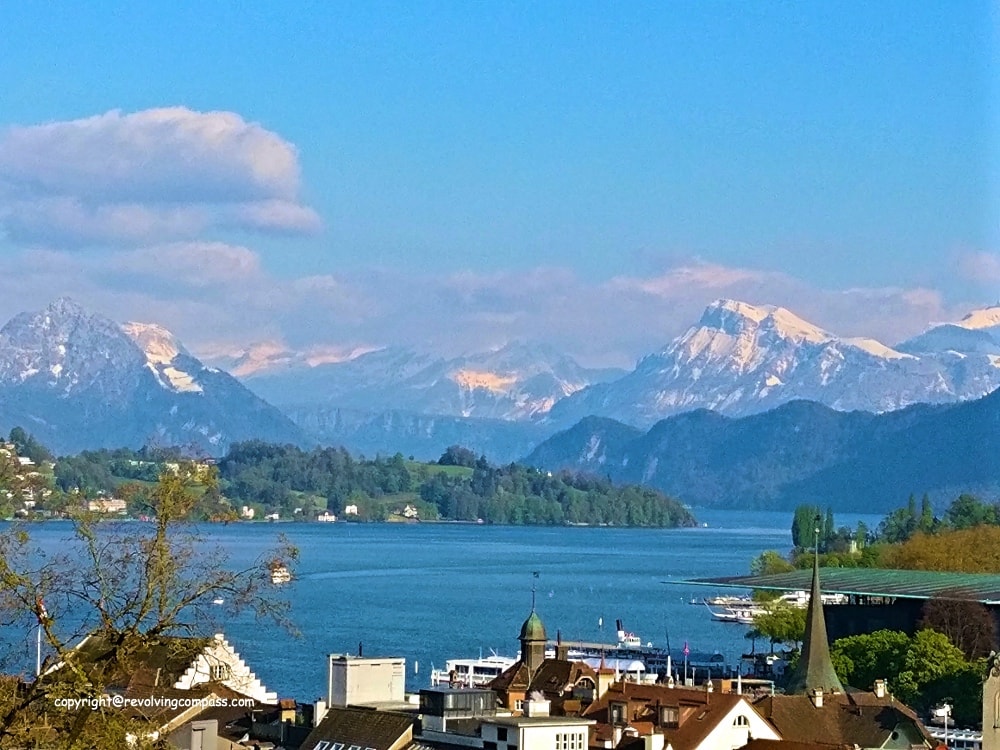
Old Town walls (Museggmauer)
After crossing through the Chapel Bridge, we continued further on our free Lucerne walking tour. Now, we navigated through some narrow lanes, to arrive at the main market of Lucerne. These markets are marked with all kind of shops from grocery to lifestyle. We lost our friend google here. So, we stopped at a few shops to ask for directions to the old town walls . Finally, we arrived at the foot of the old town walls. There is a beautifully landscaped garden developed here. And we did rest our feet a bit in this garden, sitting on the rustic benches for a while. As we started ascending the slope of the garden, we got the first glimpse of the city of Lucerne in front of us.
From here, you can see far and wide. You can see the breadth of the vast , beautiful, blue lake lucerne and the city of Lucerne spreading behind it. On the foothills of the swiss Alps that are decorated with snow laden peaks that almost touch the clouds. The beauty that spread in front of us was truly captivating. We walked further towards the clock tower that also has steps to climb on to the old wall. The walls are further up. You can see even farther from here.
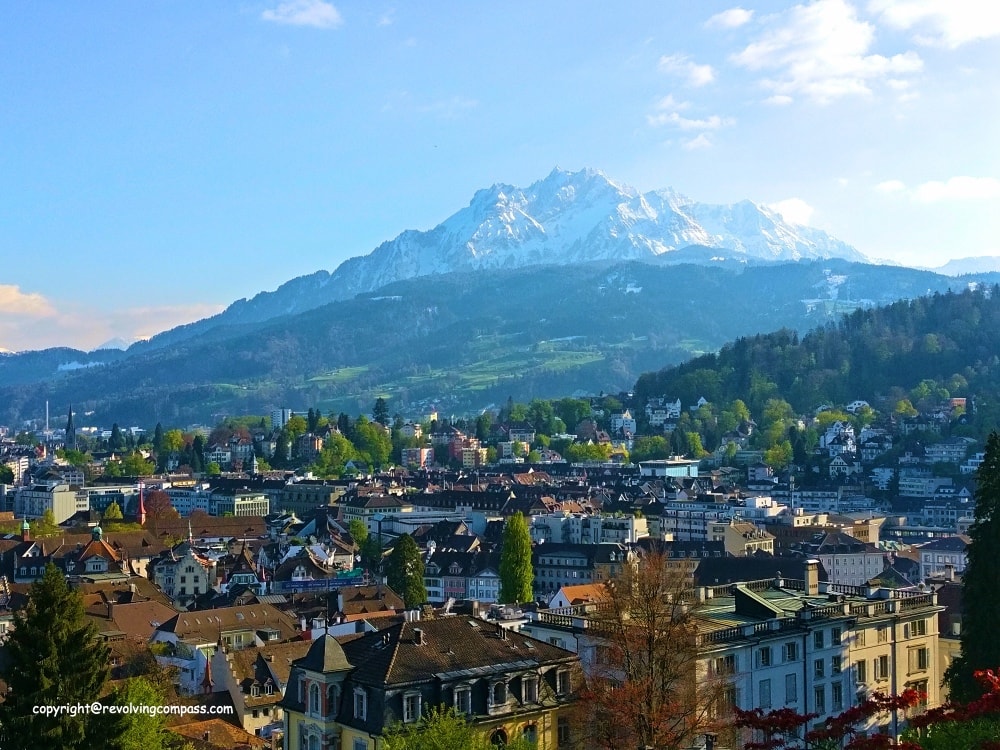
From here, we walked along the old walls, sinking in the beauty of the old town spread on one side. And a beautiful garden that spread on the other side of the wall. Finally, we arrived at the second tower. We took the steps here to get down to the garden. And back to the roads. The views from here are simply unparalleled.
Lion Monument
Famous as “The most mournful and moving piece of stone in the world” , the lion monument is yet another must visit when in Lucerne. Following our maps, we arrived at a gated small garden. And across a small pond lies the monument. It depicts a weak, wounded, dying lion from a battlefield. The expression on the face of the lion is utterly mournful. There is a great significance of the dying lion that can be understood by the story behind it.
It was built by a Danish artist Bertel Thorvaldsen in the memory of the brave Swiss guards that once guarded most of the royal families of Europe. And were brutally wiped out by an attack of the french revolutionaries. The words inscribed on the monument say “Helvetiorum fedei ac Virtuti” which translate to “To the loyalty and bravery of the Swiss”. Below this, the names of the soldiers are inscribed along with the number of those who died and those who survived. There is something else to be noted here. The cut out of the stone in which the lion lies is shaped like a pig. It is said, the creators of the monument did it out of anger on the authorities who didn’t pay him as promised upon completion of the monument. This is what he thought of the authorities !!
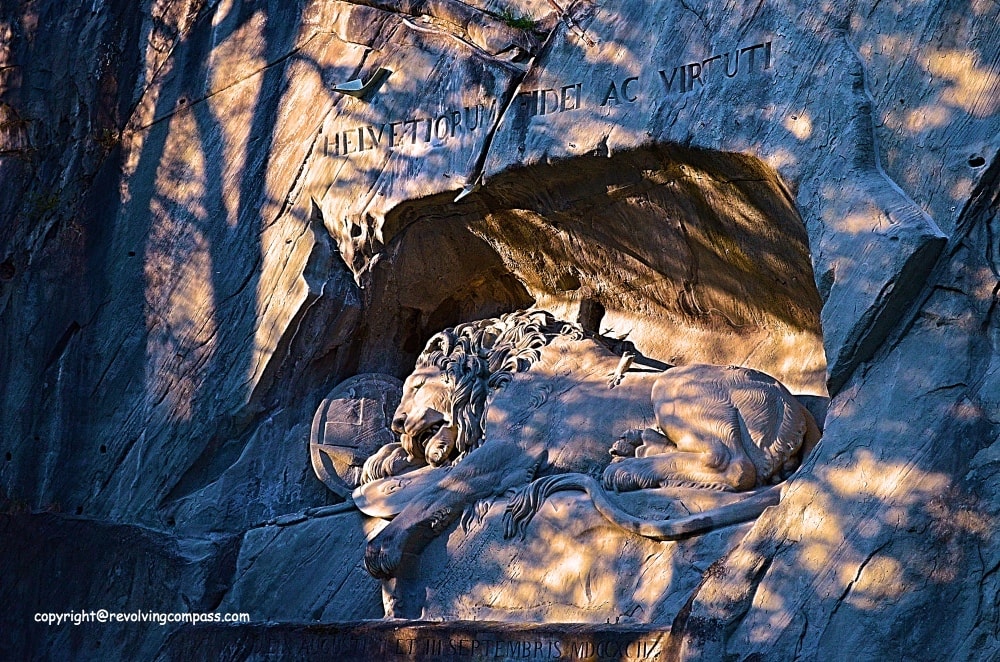
Gletschergarten or Glacier Garden
Just besides the Lion Monument lies the Glacier Garden. There is a way to step into the garden right from the premises of the Lion Monument. This will be the next stop on our free Lucerne city walking tour. The Glacier Garden was found in 1872. It consists of glacial potholes that date back to ice age era. Around these significant remnants of the ancient past, a lush green beautiful park has been developed. Since the area is highly frequented by curious people and interested scientists a lot.
Church of St. Leodegar
The Church of St. Leodegar lies on the same side of Lake Lucerne as the Lion Monument. So, this is the next suitable spot on the walking tour, before we head back across the lake. There was a Roman Basillica at the place where the church stands as of today. But it got burnt down in 1633. Thereafter the Roman catholic church was built over it’s foundations, in parts, from 1633 to 1639 AD. Finally, the parish church of St. Leodegar was founded in 1874. Thereafter it became a monastery church and parish church. The architecture of the church is very beautiful. So, this forms another must see place when in Lucerne.
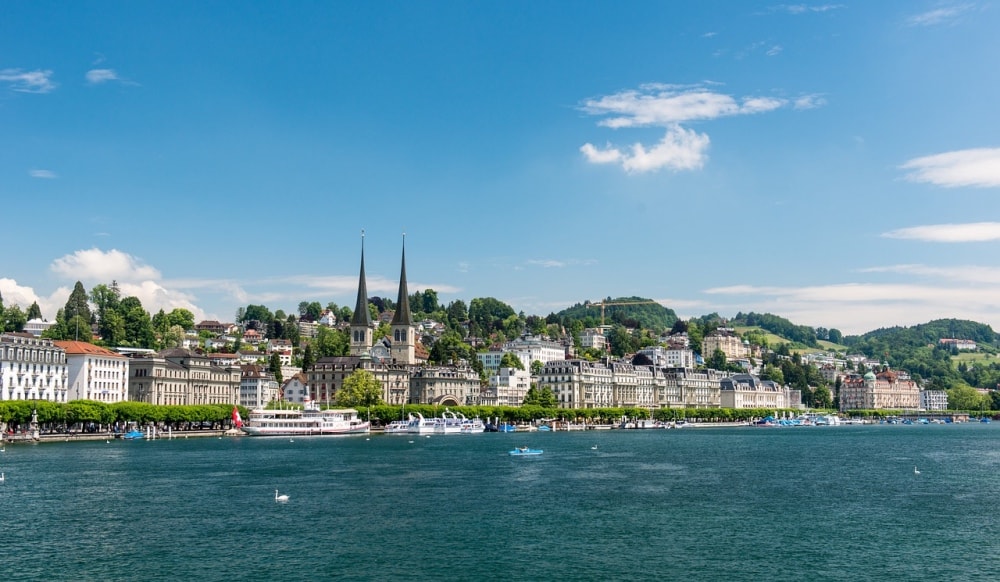
Other side of Lake Lucerne
Here I talk about the side of the lake that lies on the same side as the Lion Mountain, Hofkirche and the old town walls. As we left Hofkirche, we walked back along the banks of lake Lucerne before crossing the bridge to the other side. This side of the bridge is lined with beautiful open restaurants that include sitting besides the bank of the lake. And some open vegetable and fruit markets. We did buy some fries from one of the pubs on the banks and some fruits from a fruit stall. What particularly attracted our attention on the fruit stall was the pack of colorful eggs. They were colored in such beautiful hues that we couldn’t help but notice them 🙂 . Having done our grocery shopping, we decided to cross the lake and arrive at the final stop on our free Lucerne city walking tour.
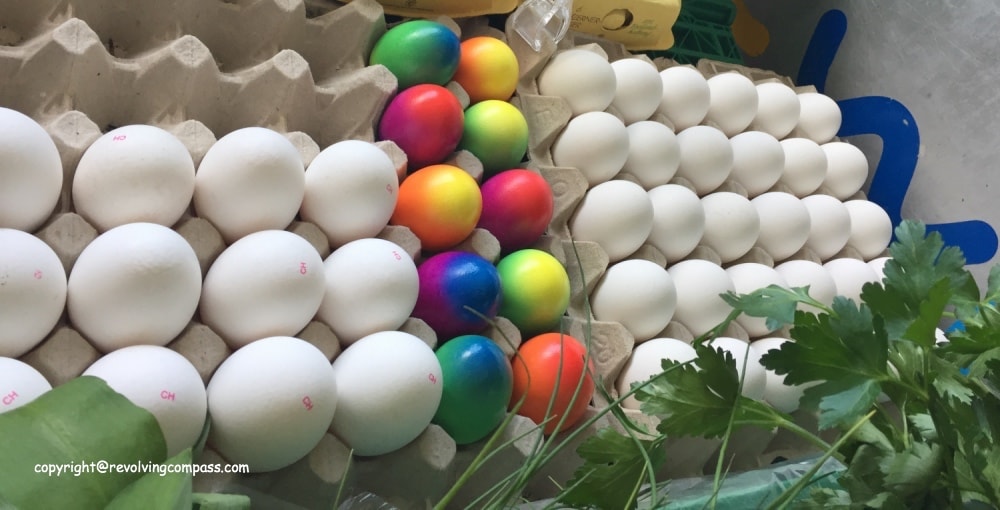
Sammlung Rosengart Museum
The most famous museum of art in Lucerne, Sammalung Rosengart forms the last spot of this free Lucerne city walking tour. It has a vast collection of art that has been formed over a period of time. The most famous ones among the collections being those of Picasso and Klee. These artwork include 132 watercolors, drawings and paintings by Klee only. Then hundred more paintings from Picasso’s era. The collection also includes work of several other artists including Monet, Cézanne, Vuillard, Bonnard, Matisse, Braque, Léger, Miró and Chagall. All these artists were highly instrumental in converting the classical paintings into abstractions. And that is where the journey of abstraction art began.
Map of the free Lucerne city walking tour
PS : While we spent 4 beautiful days in Switzerland , based out of Lucerne. There are so many other enchanting and beautiful destinations in this country to explore. We do intend to cover them on our next trip. In the meanwhile, you can read : Where all to go in Switzerland . And in case you are interested to book the day trips that we booked to go to places around Lucerne, here you go:
A day trip to Bern, Kambly cookie store and dairy and cheese factory from Lucerne
A day trip to Grindelwald and Interlaken from Lucerne
Eternal snow trip from Lucerne to Engleberg & Mount Titlis
Tips on taking free Lucerne city walking tour
- Lucerne has a picture perfect landscape like most of Switzerland. For photography enthusiasts, we recommend you take this Photography tour to capture the best in your camera.
- Carry a refill water bottle & refill it with drinking water across the different fountains in the city. Tap water is also drinkable here.
- Wear comfortable shoes as there is a lot of walking to be done. Lucerne is a pedestrian friendly town.
- Take it slow. Walk a little and then rest a little. Chew on some snacks, drink water.
- You can get public washroom during your travel in the vicinity of Hofkirche or the campus of Lion Monument.
- Do walk up to the old wall. But the stairs are steep. So, be careful.
- We visited in April and it started getting really chilly towards the evening. So, do provision for adequate winter wear depending on when you are planning to visit here.
- If possible, you can dine by the lake side as you complete the Lucerne city walking tour.
- This is the official link to the Lucerne tourism website. You can also download a guide map to the city from here.
- Zurich is the nearest airport to Lucerne. However, the town is well connected across Europe through euro rails. We arrived here from Venice .
- In case you will like to visit Zurich from Lucerne for a couple of days, here’s a list of places to visit in Zurich .
- English is well understood in Lucerne
- Swiss Francs are the main currency of the town. Although, euros might be accepted at few outlets, they will charge you the same number of Euros as the price in Swiss Francs.
- Finally, if you are on this walking tour with a toddler, take your stroller along. It will be so much easier to walk across on the tour.
PS: Some of our links are affiliated, this means we will earn a commission when you buy a service or product by clicking those links. However, this will have no extra cost for you.
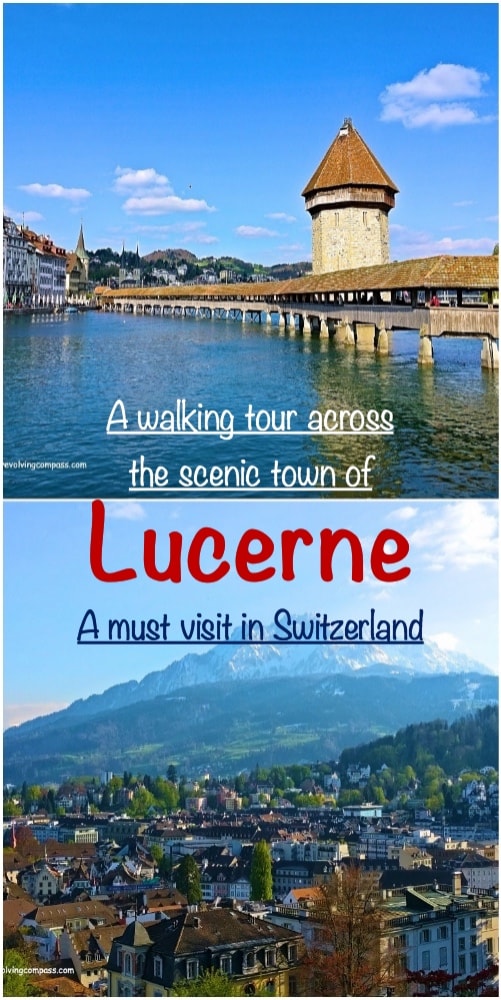
116 thoughts on “A free lucerne city walking tour”
- Pingback: our 3 days in Paris - The Revolving Compass
- Pingback: 6 Kid Friendly Travel Snacks that every Mom should know - The Revolving Compass
- Pingback: Guided tours vs Independent travel - The Revolving Compass
- Pingback: Things to do in Melbourne - our Melbourne bucket list - The Revolving Compass
- Pingback: 6 Smart Ways to Cut Your Travel Costs - The Revolving Compass
- Pingback: A virtual tour of the Punakha Dzong - the second largest fort of Bhutan - The Revolving Compass
- Pingback: A cheese factory tour in Switzerland - The Revolving Compass
- Pingback: 7 Tourist scams in Kashmir - know before you go! - The Revolving Compass
- Pingback: Four days in Switzerland : Our beautiful itinerary - The Revolving Compass
- Pingback: Our 2 weeks Europe trip itinerary with kids - The Revolving Compass
Leave a Comment Cancel reply
Save my name, email, and website in this browser for the next time I comment.
By using this form you agree with the storage and handling of your data by this website. *

Want to share your culture with travelers from all the world?
Free walking tour near lucerne, others cities to visit after lucerne, where are you traveling to.
Home » Destinations » Cities & Villages
Lucerne walking tour for families

- Last Updated: 3 Apr 2011
- By Tanya, Founder of Swiss Family Fun
If you buy something through a link here, we may earn a commission. See our disclosure policy . Note that p rices and opening times may change without notice.
Lucerne is a beautiful lakeside city in Central Switzerland with mountain views and many charms. The main attraction is the much photographed wooden bridge that crosses the large river cutting through town. It also has brightly decorated fountains scattered around the old town, the old castle wall looming over the city, the waterfront for strolling, and interesting churches and museums to visit.
It’s well worth doing a guided or self-guided tour of the city for a half day. I have a suggested route below for families, a mini tour that hits the main highlights without exhausting the kids.
Location
City overview, how to get there, walking tours, tower bridge, historic old town, lion monument.
Lucerne is located in central Switzerland, about 40mins southwest of Zürich and about 1hr east of Bern. It’s a good home base for exploring a wide variety of many beautiful destinations in Switzerland. See our Lucerne & Central Switzerland Guide .
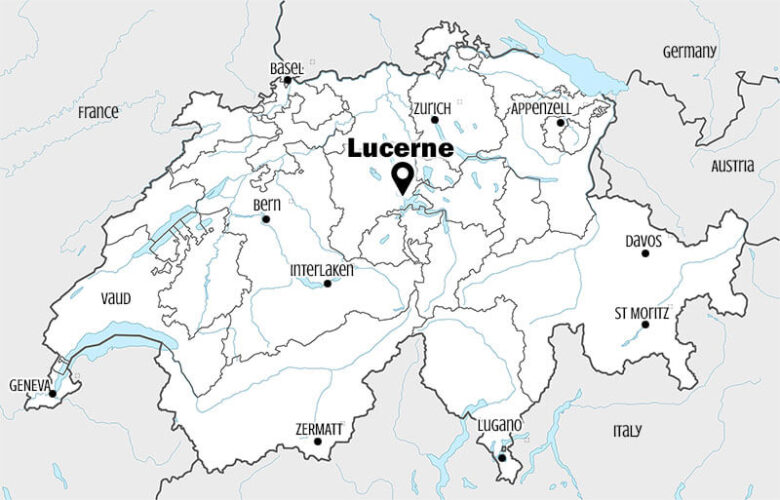
Below is the official city map you get on the free brochure available at any tourist information desk. You can also download it . The historic old town is mostly pedestrian-only, making it fun and easy to explore with kids. Most points of interest are clustered around the old town and can be easily reached by foot.
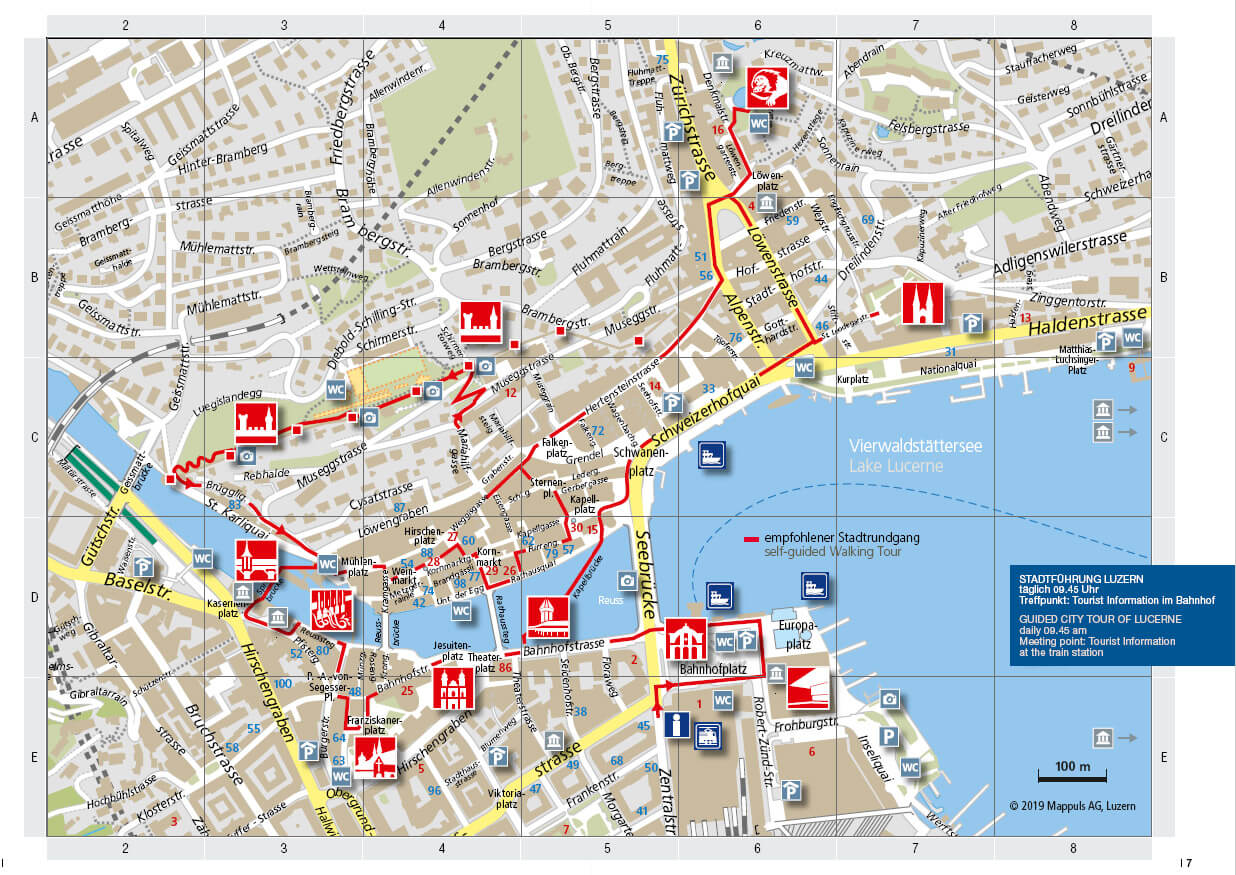
I prefer to take public transport to Luzern because traffic can be bad in the city center. But I have some tips for you below.
By train: Take the train to Luzern, Bahnhof . Everything is within walking distance of here.
By car: Drive to Luzern. We prefer to park at Parkhaus Altstadt ( Baselstrasse 4, 6003 Luzern ), which is a bit more affordable and more importantly, has easy access to the freeway without having to drive through the city. As an example, it costs CHF 12.50/ 6 hours. It’s a pretty walk along the river, about 15 mins, to reach the piers, as shown below.

If you prefer to park more in the center, you can park at the P1 or P2 underground parking at the train station ( Bahnhofpl. 1, 6002 Luzern ). After parking, you walk through the train station and exit to the city above. But these parking lots are the most expensive, CHF 16.50/6 hours. When you drive in, you’ll see P1 and P2 to your left and P3 to your right, a bit farther away. They all start at CHF 4 for the first hour, but P1 & P2 are slightly more expensive at CHF 2.50 for each additional hour, while P3 is CHF 2 for each additional hour.
See all Luzern parking options and download a PDF with a price comparison between all garages.
There are many walking tour options. Here are just a few to get you started.
- Lucerne has a free audio tour that you can download on your phone. It has suggested routes or you can plan your own.
- Lucerne tourism offers a guided walking tour in English on Fridays at 9:45. It costs CHF20/adult, CHF5/child, discounted with a Lucerne visitor card free from your hotel. They also have themed tours , like the FoxTrail treasure hunts and “city of water” tour .
- Free Walk does a 2 hour tour around the city. It’s free, but tips are expected (I would tip about CHF 5-10 per person).
- GPSmyCity has a few different self-guided tours with different themes.
- If you want to minimize the walking, you can ride the tourist train , which runs daily April to October, hourly from 11:00. It’s a 40 min tour and costs CHF 12/adult, CHF 5/child
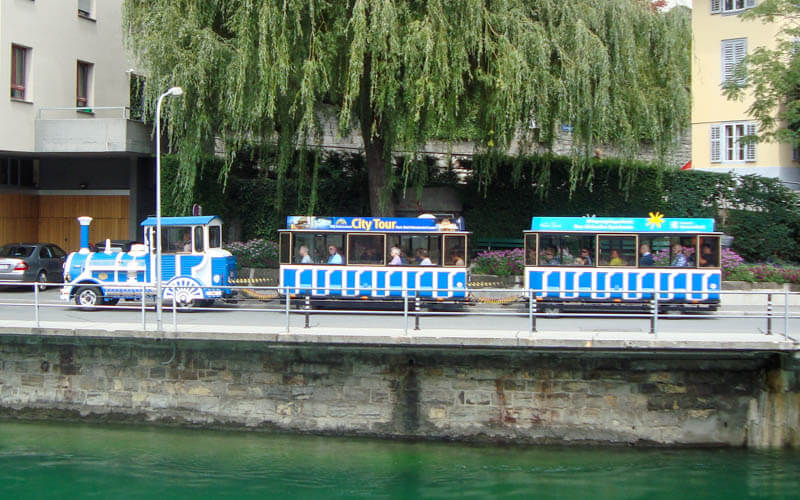
Although I certainly suggest the longer tour so you can see everything, kids usually have little tolerance for walking tours. So here’s my shorter 2km route for families that hits several highlights and includes a stop for gelato. Generally, the town is possible with stroller, but the cobblestone streets are bumpy and there are a few stairs.
If you have time and energy, I definitely recommend walking up to the city wall and climbing up to the ramparts. I’ll show that detour below.
I won’t repeat a full walking tour here but merely mention a few highlights. The wooden bridge is a must-do, so drag your stroller up the few stairs and enjoy the stroll. If the kids need motivation, there is a Dieci gelato shop on the east side of the river, between the wooden bridge and the metal bridge.
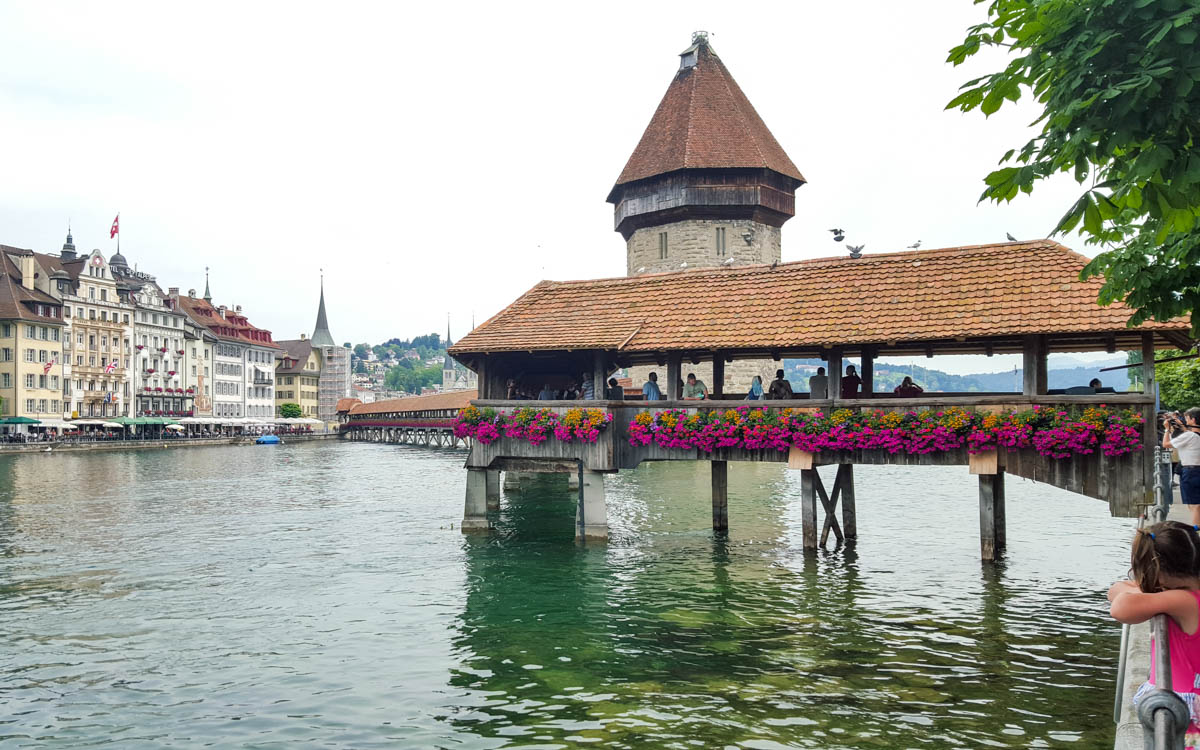
Most of the bridge and the paintings inside were destroyed in the 1993 fire. Since then it has been rebuilt and restored. Learn more about the bridge and the fire .
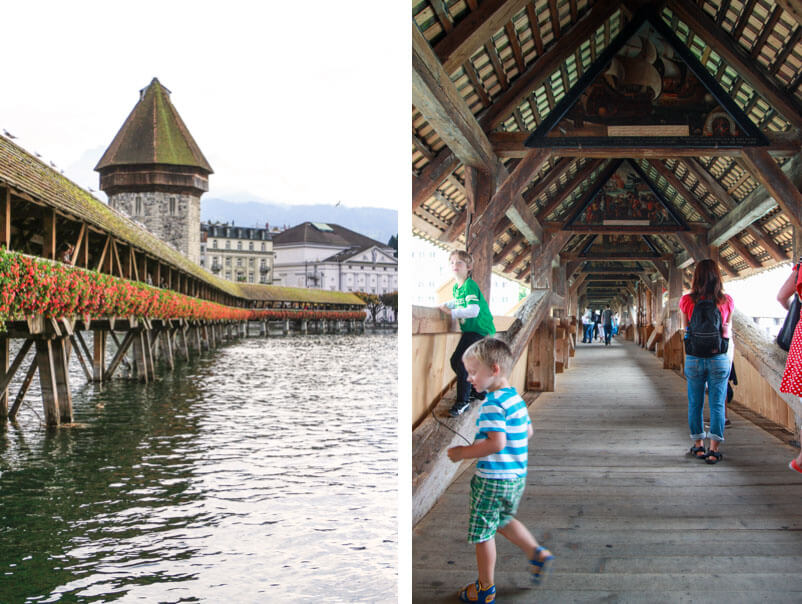
The old town has lots of elaborate wall paintings. It can fun to have the kids look for things in the paintings. But some of them are a bit scary, so consider yourself warned.

Luzern is famous for its elaborate fountains (see online fountain guide ). Most have drinkable water.

The river flows very fast and the gaps in the barrier are very wide so a child could easily flop right in if they start climbing on the railings. So watch those little ones carefully.

I recommend stepping inside the Jesuit church on the river.
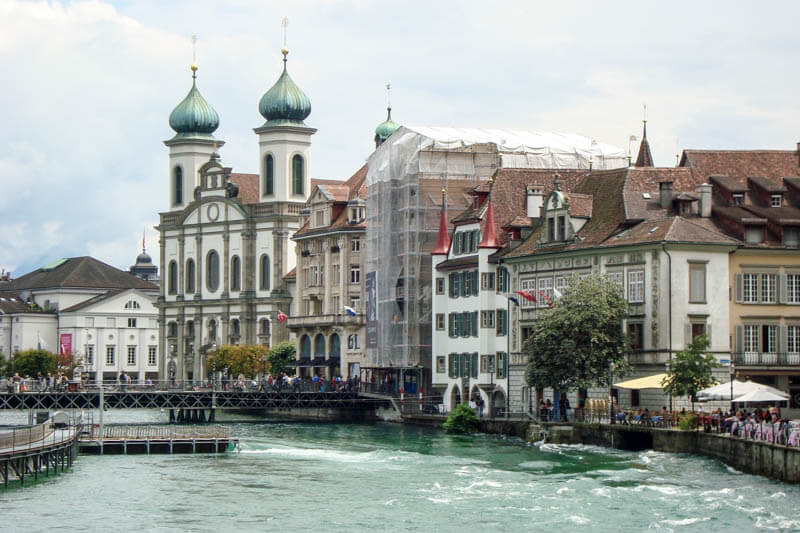
It has a similar super elaborate style to the Einsiedeln monastery but unlike that one, you can take pictures inside here.

Other pretty bridge across the river.

If you have time and energy, I recommend the short walk up to the city wall and climb up the ramparts if it’s open. Both times we’ve been there the ramparts were closed, so check the website . It’s usually open April through October, 8:00 to 19:00.
I’ve shown a route leaving from the train station, but you can start anywhere in the city.
This is path is not possible with strollers because of all the stairs.

It’s very green and quiet up here, a nice break from the city.

This is not on my mini-tour because it’s outside the pedestrian-only city center and you have to walk on busy city streets to get there. With little kids, this was asking too much. But if you have time and energy, you should visit this iconic spot. Next door is the Gletschergarten museum (glacier garden) which I haven’t visited and therefore have no opinion.
According to their website: «The dying Lion of Lucerne» is one of the world’s most famous monuments. It’s not in the old town, you have to walk a bit through the not-particularly attractive commercial part of town to get there.
- TAGS: Cute Town
You might also like
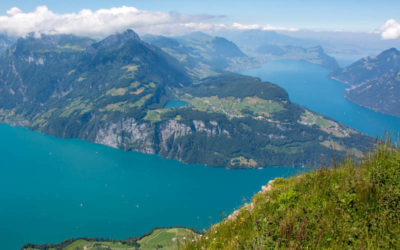
Support us!
When you book something through our links, it costs you the same but we earn a small commission. This support helps us keep our website free to use. Thanks!
via SkyScanner
via Booking.com
via DiscoverCars

via GetYourGuide
We respect your privacy. Please review our privacy policy to understand how we process and store data submitted through the comment form below. If you submit this form, you explicitly agree to the terms described in our privacy policy.
4 Responses
Will be coming by car on 28/08/23 from Rhinefall to Lucerne. where do we park the car to avoid long walk (1 or 2 Km walk is ok) and cover the kapeli bridge, lion monuments , bucherer watch shop and lake opposite . Also how far is Lake of Four Cantons from Kapeli and is it possible by walk or we can take car. we shall reach at around 3.30 Pm At lucerne.
The Lucerne train station parking garage is the most convenient. It is very close to the lake and wooden bridge, a 15 min walk to the Lion Monument. Another option would be the City Parking garage, which is close to the Lion Monument – Zürichstrasse 35, 6004 Luzern. In any case, there is a fair amount of walking to see all sites in Lucerne city. Good luck!
It's possible, but it is bumpy. A sleeping baby might wake up. Good luck!
do you think its possible to walk around old town with a stroller? or will it be too bumpy?
Leave a Reply Cancel reply
Your email address will not be published. Required fields are marked *
Save my name, email, and website in this browser for the next time I comment.
Hi! I’m Tanya and our family has been living & hiking in Switzerland since 2005, collecting dozens of fun hikes and activities for all ages and abilities. More about us…
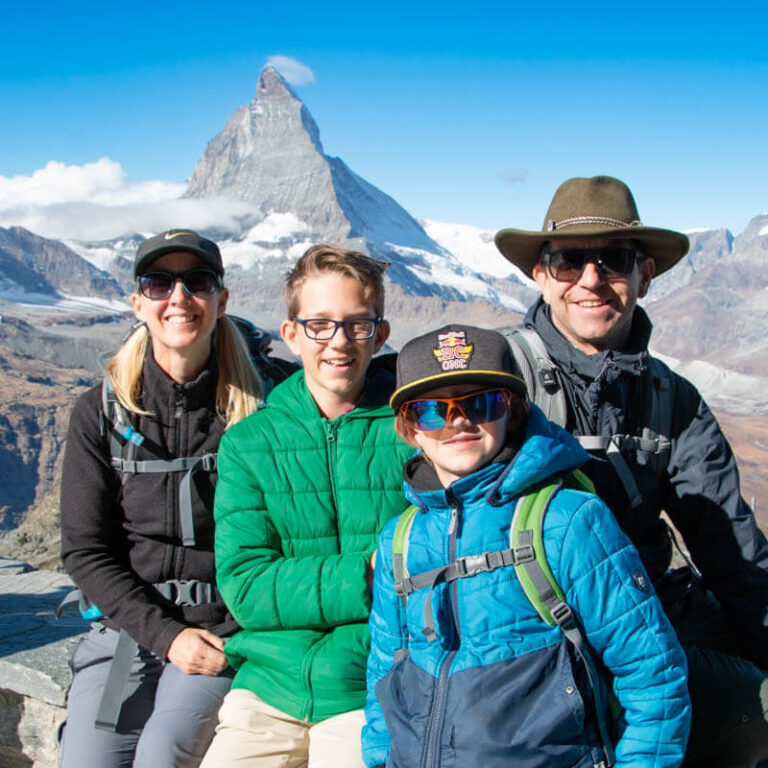
Need help planning?
Short on time? Get our interactive map with curated itineraries. Learn more…
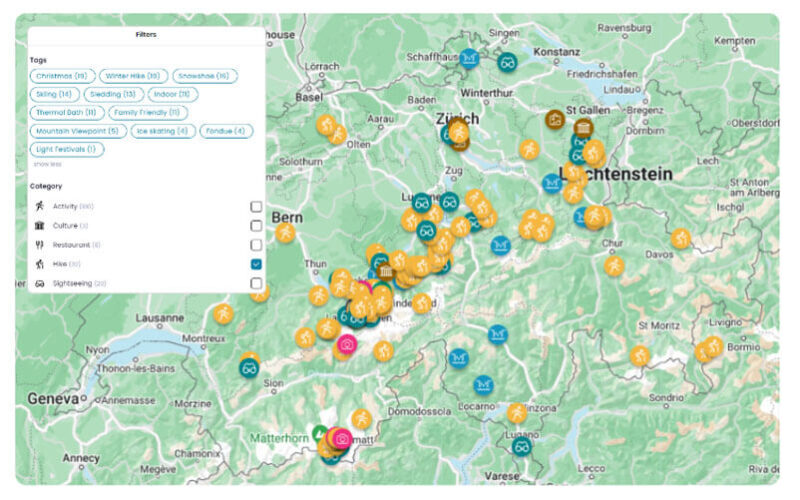
Have questions? Book a video call with me to create a custom itinerary.
Need inspiration? Get our Switzerland Bucket List ebook with twenty “Top 10” checklists.
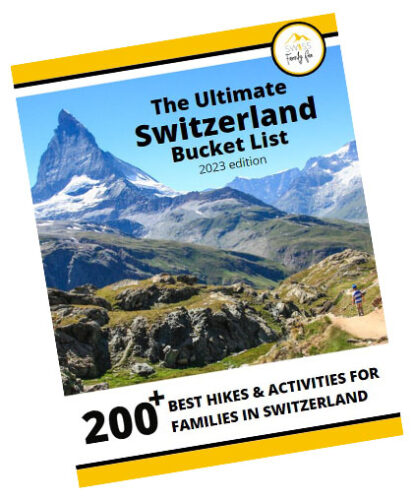
Subscribers may login below. At the moment, membership is by invite only.

Welcome to Lucerne
Discover lucerne through the eyes of a local.

We are also happy to offer tailored private tours, please contact us for more details. Free Walk Lucerne does not take any liability for accidents, thefts or any other damage during the walk. © (copyright) by Free Walking Tours Switzerland (Free Walking Tours Switzerland is a non-profit organization registered as an association under Swiss law.) Impressum .
Lucerne Printable Tourist Map

Lucerne Map: The Attractions
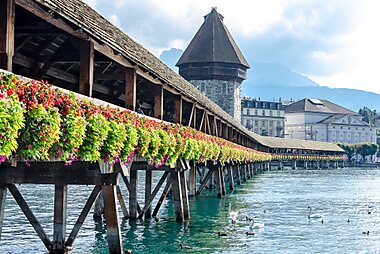
Chapel Bridge
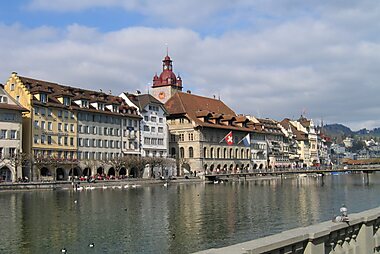
Old Town Lucerne
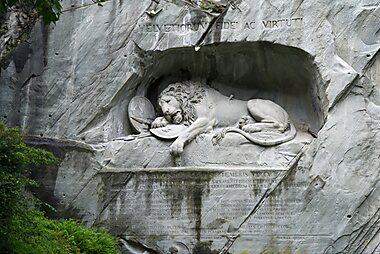
Lion Monument
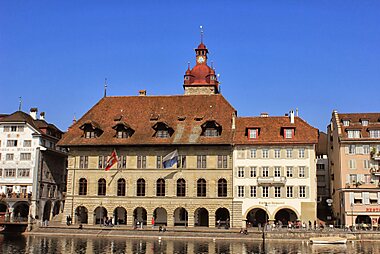
Lucerne Town Hall
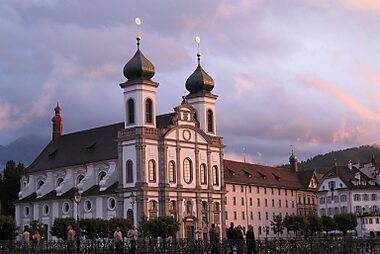
Jesuit Church
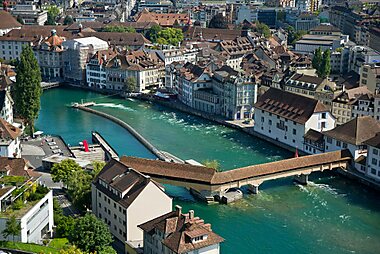
Water Spike
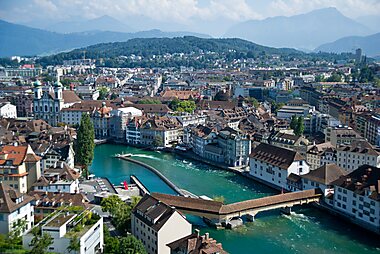
Spreuer Bridge
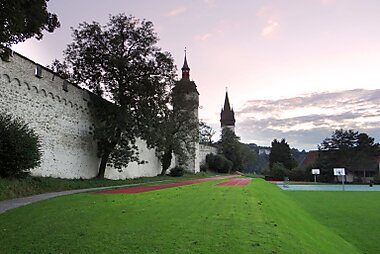
Musegg Wall
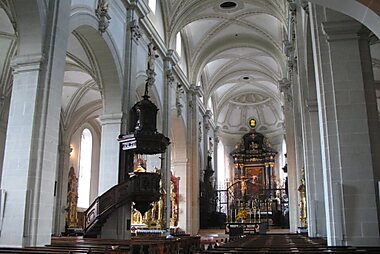
Court Church of St. Leodegar
Sygic travel - a travel guide in your pocket.

More Tourist Maps
- Privacy Policy
- STOCK 360° TRAVEL VIDEOS

IMAGES
VIDEO
COMMENTS
A single ticket was in January 2022: CHF 2.50. The Funicular is self-operated, push the button and in only a few minutes you are up at the Hotel Gütsch. A sculpture park, the Grand Tour photo spot and the beautiful hotel are all overlooking the City of Lucerne. Without a doubt it is gorgeous.
This walking tour starts at the main train station. Find details about reaching Lucerne here: Lucerne - traveling to and in the town; ... Map with the Lucerne walking route. Maps are available to members only. Check out all the benefits members have access to. Create a free account.
Self Guided Walking Tour of Lucerne (With Maps!) Famed for its meticulously preserved medieval architecture overshadowed by the grandeur of snow-capped Alps, Lucerne stands out as one of Switzerland's most charming cities. Nestled snugly on the banks of its namesake lake, its vibrant Altstadt (Old Town) is flanked to the north by a 14th ...
Walking tour of Lucerne Switzerland. If you only have a few hours in Lucerne, you should focus on walking around the city center and the lake area. On the map, you will find all the important points connected to form a pleasant walk that will help you discover the main attractions of Lucerne.
This itinerary makes a great 1-day visit to Lucerne. Enjoy a self-guided Lucerne Walking Tour of both New and Old Town. Cross the famous Chapel Bridge. Explore the towers of the Musegg Wall; OR Visit one of Lucerne's museums. Enjoy a dinner cruise on Lake Lucerne.
Self-guided walking tours in Lucerne, Switzerland. Follow these 3 expert designed self-guided walking tours to explore the city on foot at your own pace. All Cities; ... Each walk comes with a detailed tour map as well as photos and background information for the featured attractions. The app's navigation functions guide you from one attraction ...
Below is a map showing their exact location and the route for this half-day Lucerne old town walking tour itinerary. Train Station To Chapel Bridge. Chapel Bridge to Jesuit Church. Jesuit Church to Spreuer Bridge. Spreuer Bridge To Musegg Wall.
Spreuer Bridge Lucerne. Find out why Lucerne is called The City of Lights and other interesting facts about the city on this informative and entertaining 2-hour walking tour.You'll meet your guide at the Tourist Information Luzern shop and head out to see the Chapel Bridge and water tower, the Spreuer Bridge, and the iconic Museggmauer city wall.. You will get to admire the historical ...
If you are using public transport to get to Lucerne, most likely you will arrive at Lucerne train station. So start your self-guided city walking tour from there. Lucerne train station. After the fire of 1971, the whole station area has been newly built. Lucerne's new terminus station was officially inaugurated in 1991.
Guide Name: Lucerne Introduction Walking Tour. Guide Location: Switzerland » Lucerne (See other walking tours in Lucerne) Guide Type: Self-guided Walking Tour (Sightseeing) # of Attractions: 12. Tour Duration: 2 Hour (s) Travel Distance: 4.2 Km or 2.6 Miles. Author: doris. Sight (s) Featured in This Guide:
Enjoy an exceptional walking tour of Lucerne. Stroll through the City of Lights and discover its famous Chapel Bridge with the octagonal water tower. It forms part of the historical city walls together with the Spreuer Bridge and the Museggmauer with its 9 towers. Stroll through the city and discover many other sights including the modern ...
Walking Tours in Lucerne. Start: Schwanenplatz. Finish: Kurplatz. Time: 2 1/2 Hours. Best Times: Any Sunny Day. Worst Times: Rush Hours, Monday to Friday from 8 to 9am and 5 to 6pm. The best way to see Lucerne is on foot, going along its lakeside quays, across its old squares, and through the streets of its Old Town.
A self designed, free walking tour of Lucerne City with customizable google map, covering iconic places like chapel bridge, old town, lion monument etc. ... Map of the free Lucerne city walking tour. PS: While we spent 4 beautiful days in Switzerland, based out of Lucerne. There are so many other enchanting and beautiful destinations in this ...
Tour Duration: 2 Hour (s) Travel Distance: 2.3 Km or 1.4 Miles. Self-guided walking tour: Lucerne's Towers Walking Tour in Lucerne, Switzerland. The detailed walk route map can be downloaded to your mobile device for turn-by-turn travel directions.
Free walking tours in Lucerne 290 opinions from other walkers about Lucerne tours 4.92 290 ratings. Jacob 11 Mar 2024 Verified booking Travelled in couple - Mar 2024 Great and entertaining tour Secrets of Old Town Lucerne - Free walking tour Lars 10 Mar 2024 Hamburg
Lucerne tourism offers a guided walking tour in English on Fridays at 9:45. It costs CHF20/adult, CHF5/child, discounted with a Lucerne visitor card free from your hotel. They also have themed tours, like the FoxTrail treasure hunts and "city of water" tour. Free Walk does a 2 hour tour around the city.
The walking tour of Old Town Lucerne offers a flexible tour length, allowing participants to fully enjoy the city's beauty.; A knowledgeable guide leads the way to significant historical landmarks, including the iconic Kapellbrücke and the majestic Lion Monument.; Participants can experience the rich history of Lucerne firsthand, with virtual reality experiences that bring the city's ...
Enjoy a 1-hour boat trip around Lake Lucerne. Discover the beauty of Lucerne like the locals. Full description. The city of Lucerne is set against an impressive mountain backdrop. Walk with your guide through the beautiful old town and enjoy spectacular views of the Swiss Alps. On this 3-hour tour, admire architectural gems and centuries-old ...
Interactive map of Lucerne with all popular attractions - Chapel Bridge , Old Town, Museggmauer and more. Take a look at our detailed itineraries, guides and maps to help you plan your trip to Lucerne. ... Tour the magnificent bays of Lake Lucerne aboard an elegant ...
Welcome to Lucerne discover Lucerne through the eyes of a local all tours. We are also happy to offer tailored private tours, please contact us for more details. ... (Free Walking Tours Switzerland is a non-profit organization registered as an association under Swiss law.)
See the best attraction in Lucerne Printable Tourist Map. Deutschland United States France Brasil 中国 Lucerne Printable Tourist Map. Print the full size map. Download the full size map. Create your own map. Lucerne Map: The Attractions. 1. Brutinsel. See on map. 2. Chapel Bridge. See on map. 3. Old Town Lucerne ...
Bahnhofplatz, 6003 Lucerne. Duration: 3 hours. two hrs walking tour one hr boat trip with audioguide in several languages. Transportation. We will mainly walk around Lucerne and take a lift to Lucerne Castle. One hour scenic boat trip is also included. What's Included. Guiding Services; Other: - One-hour scenic cruise on the panorama yacht ...